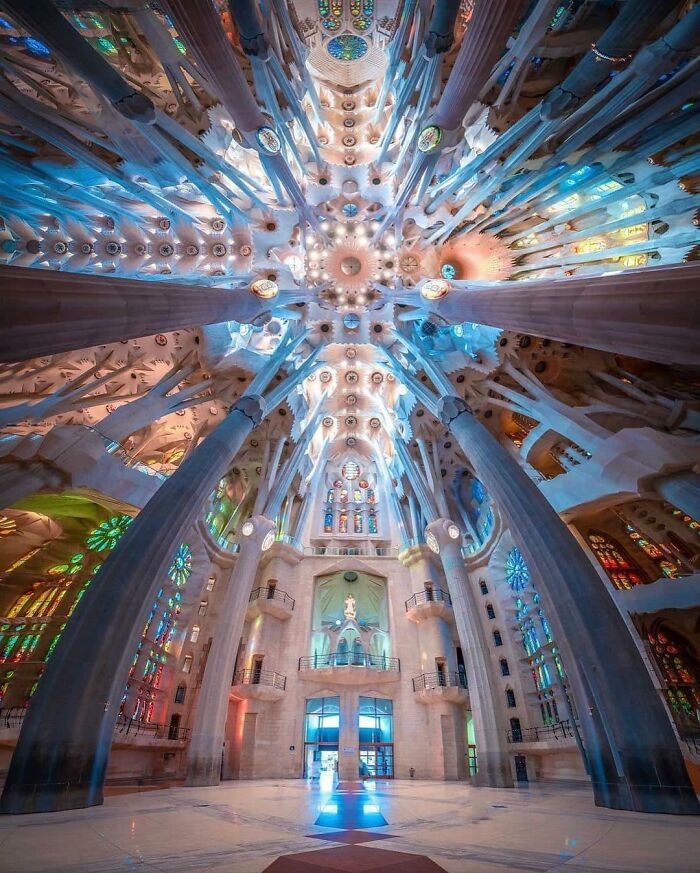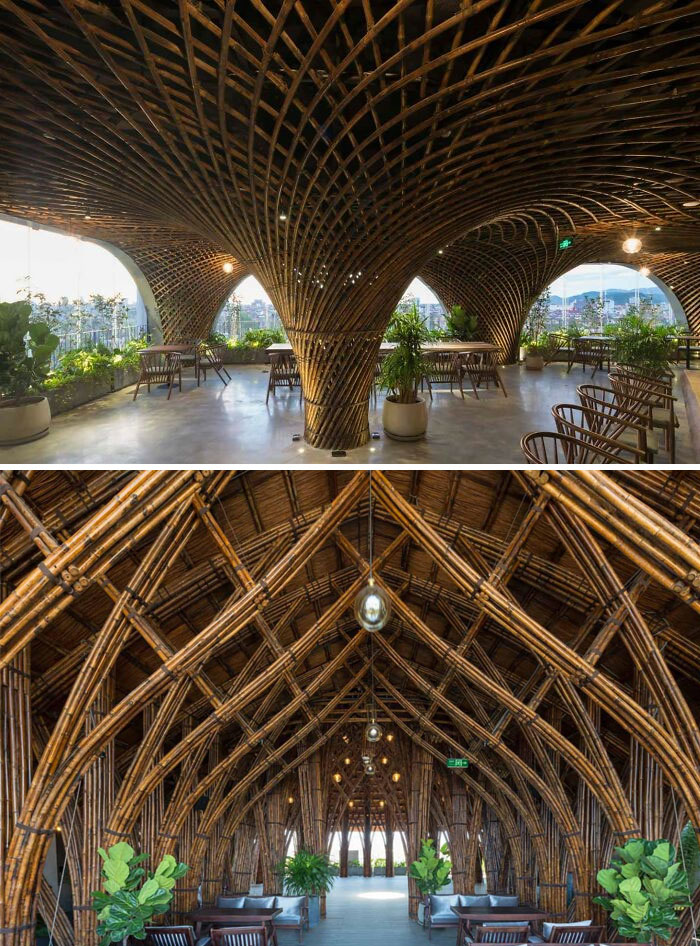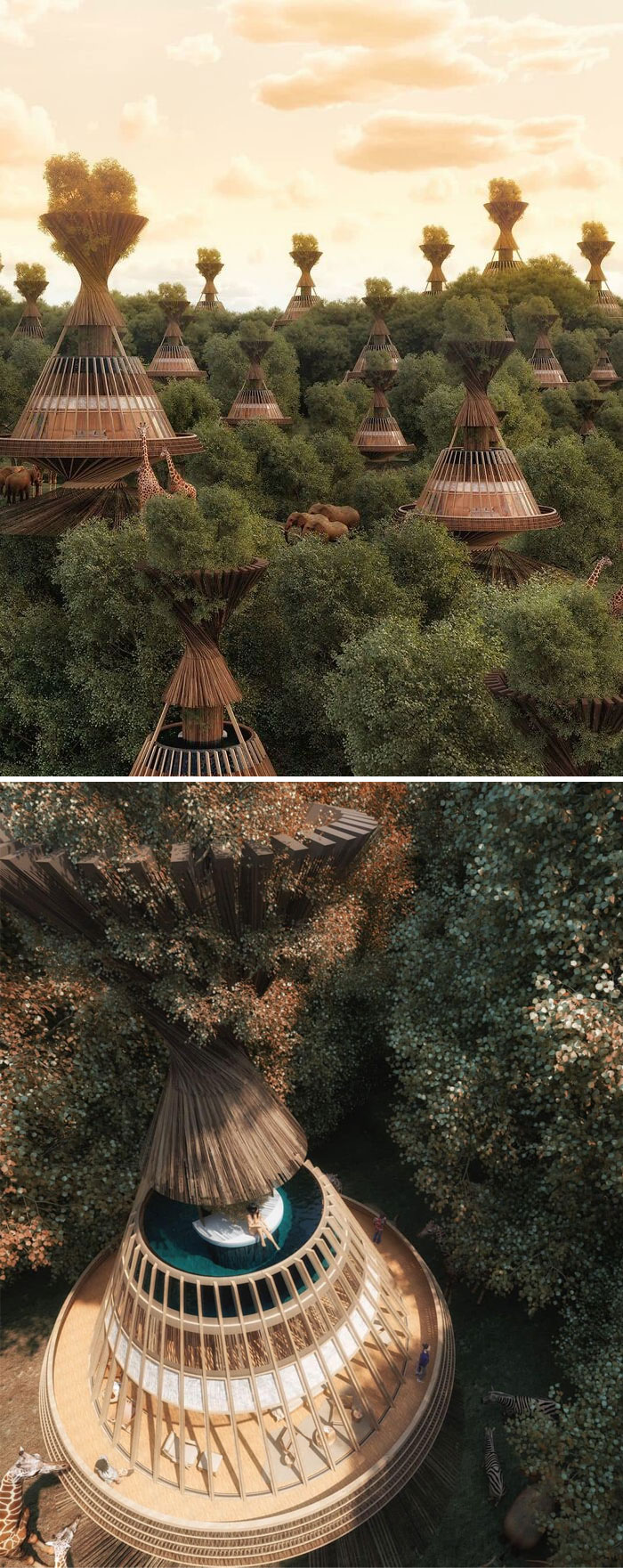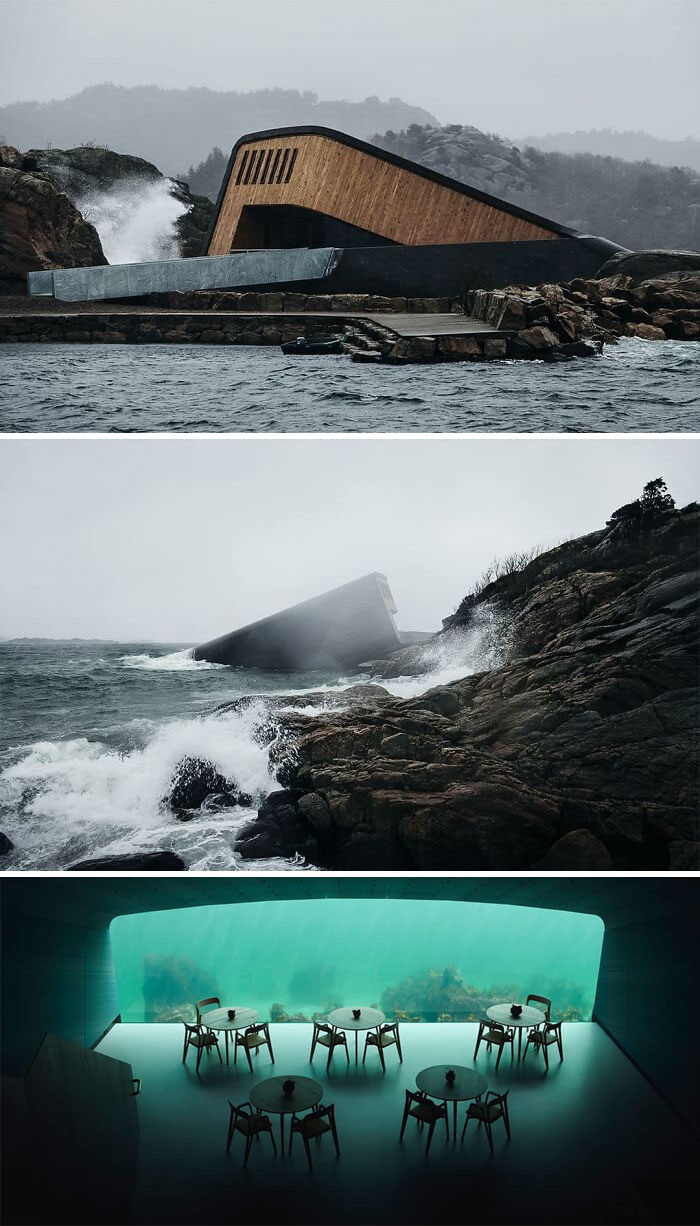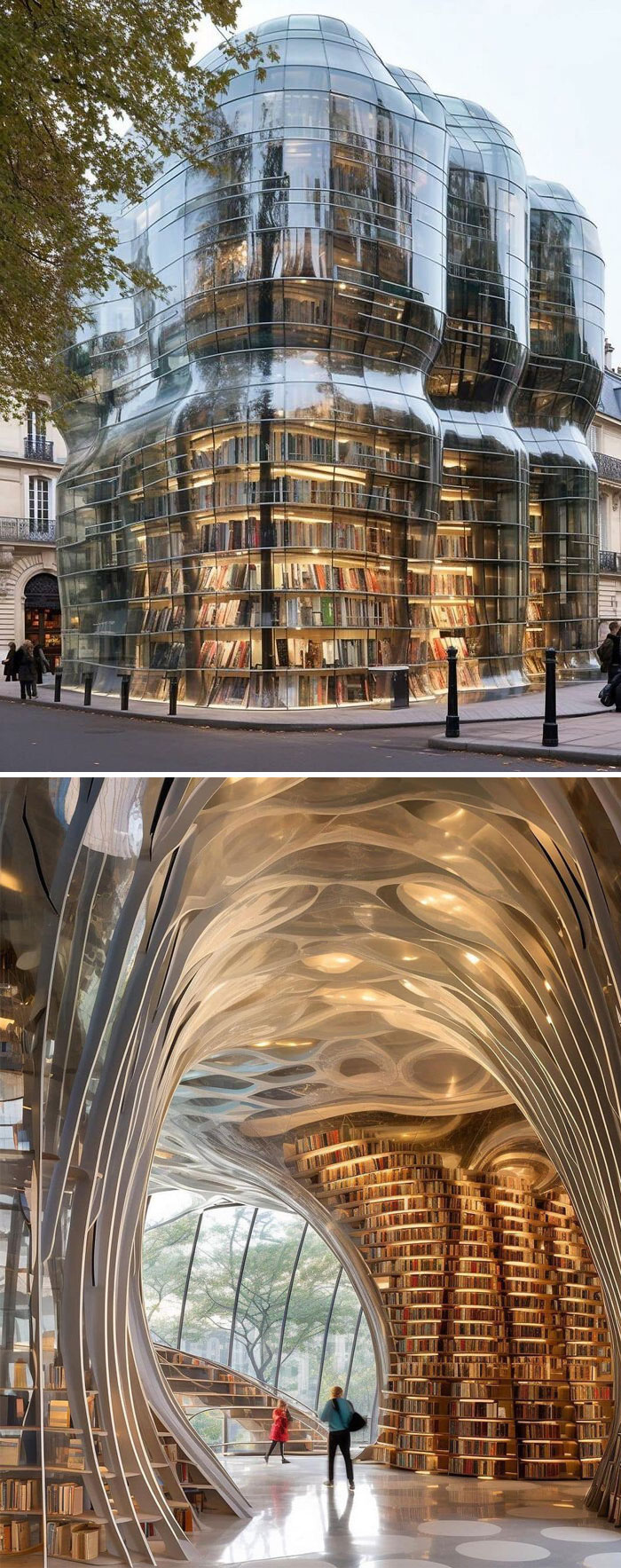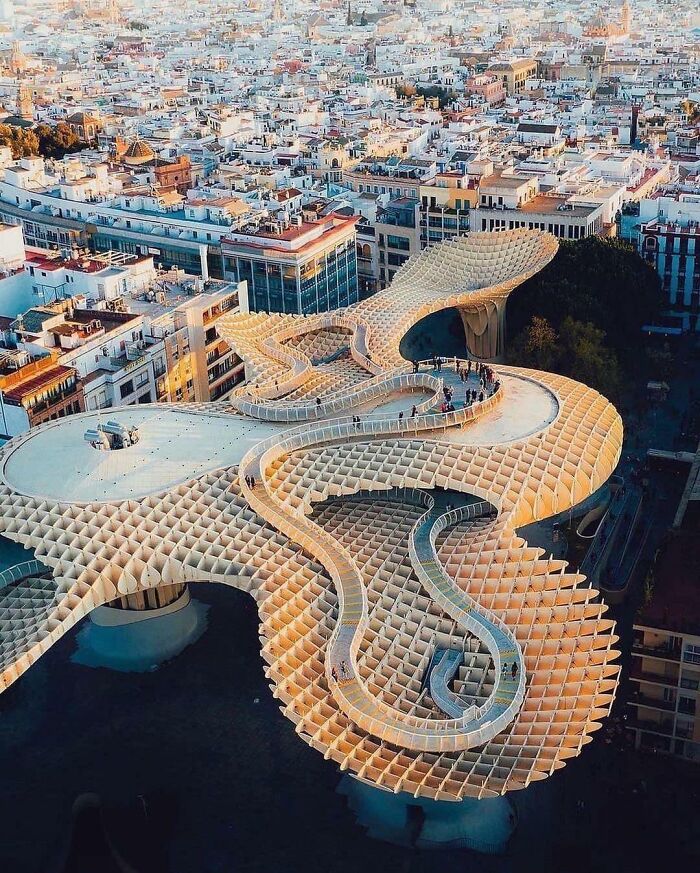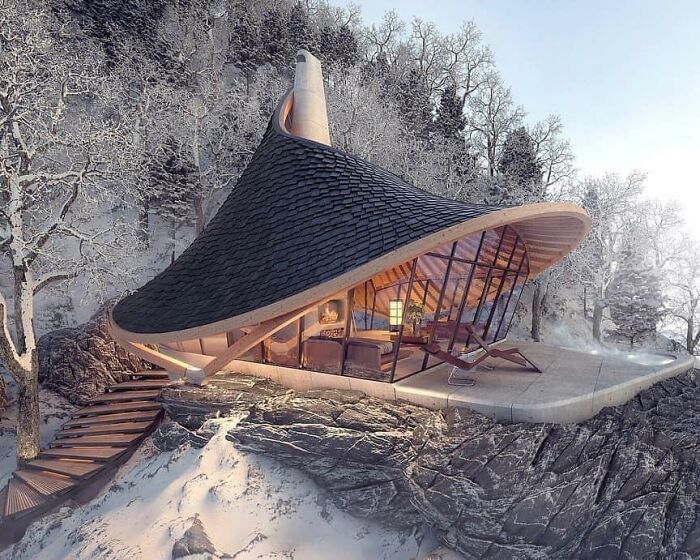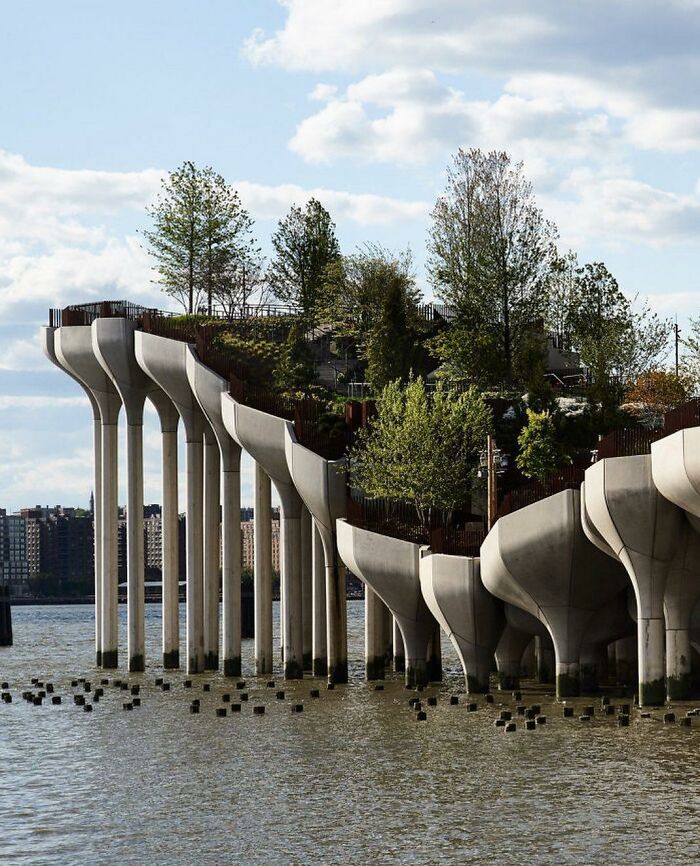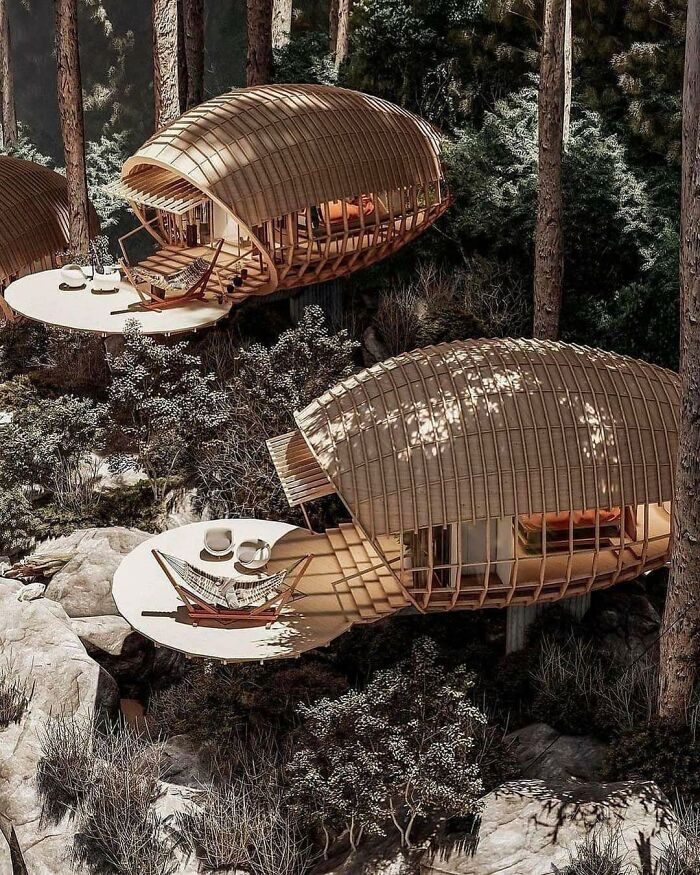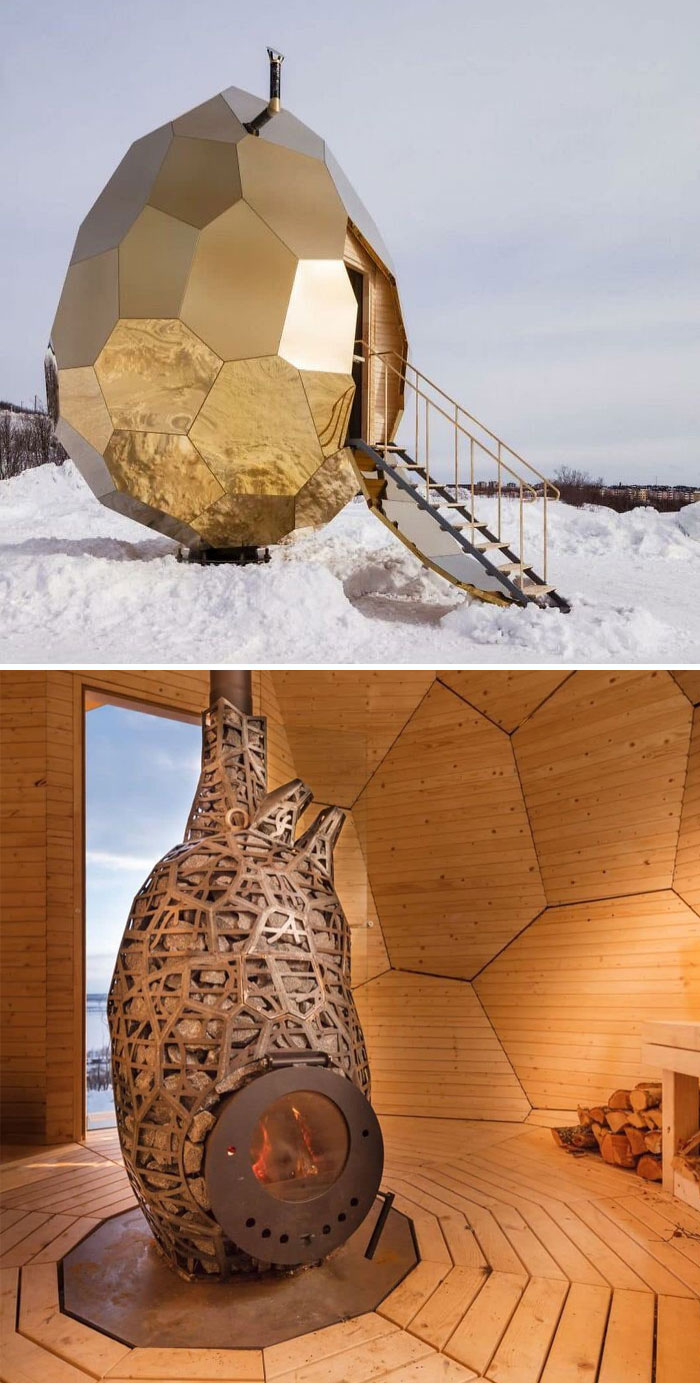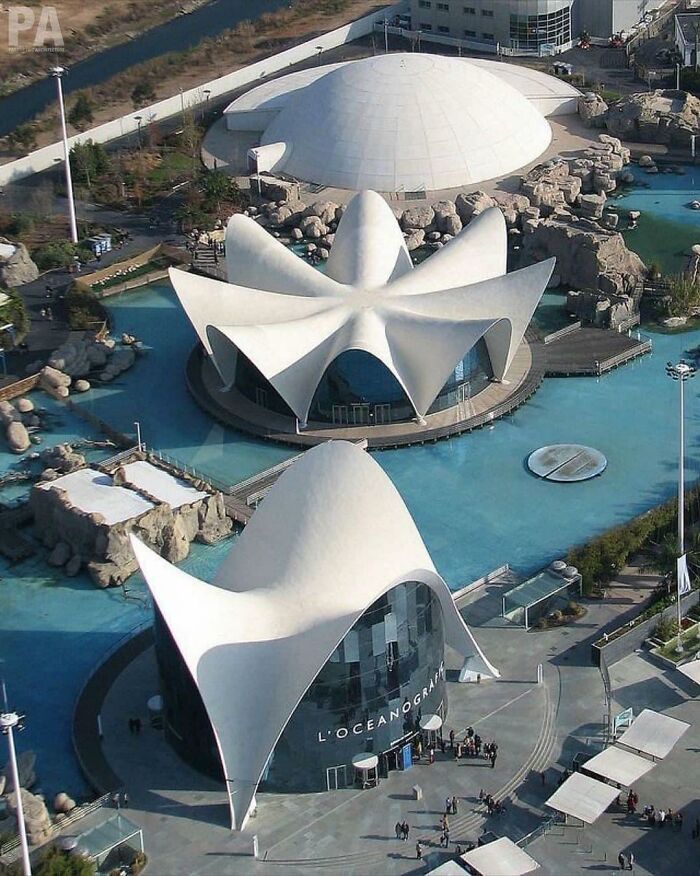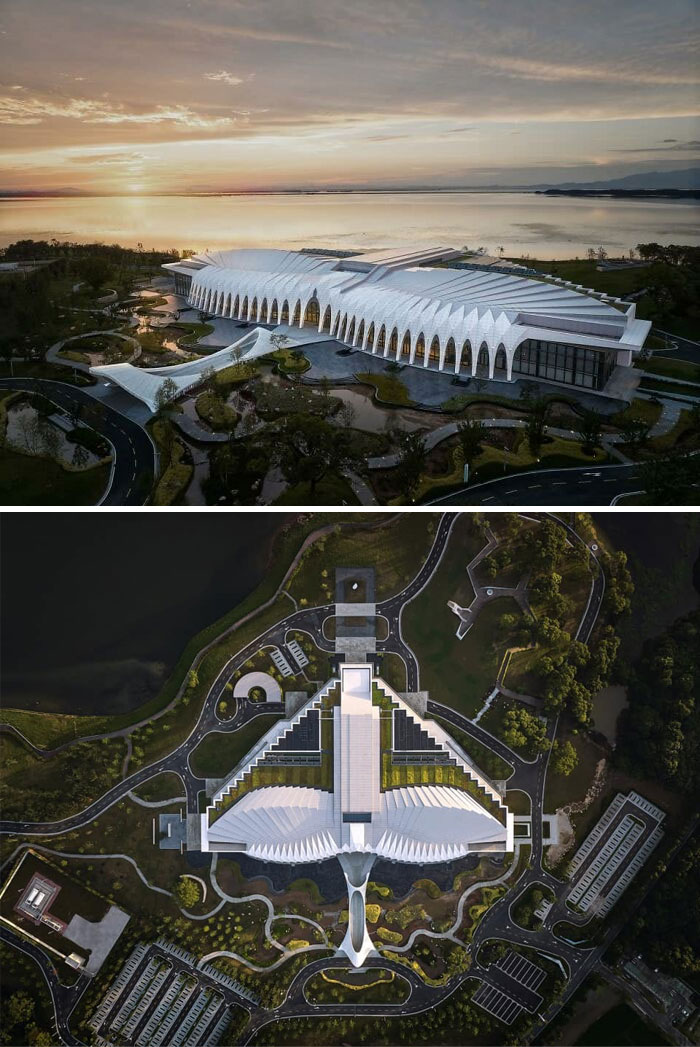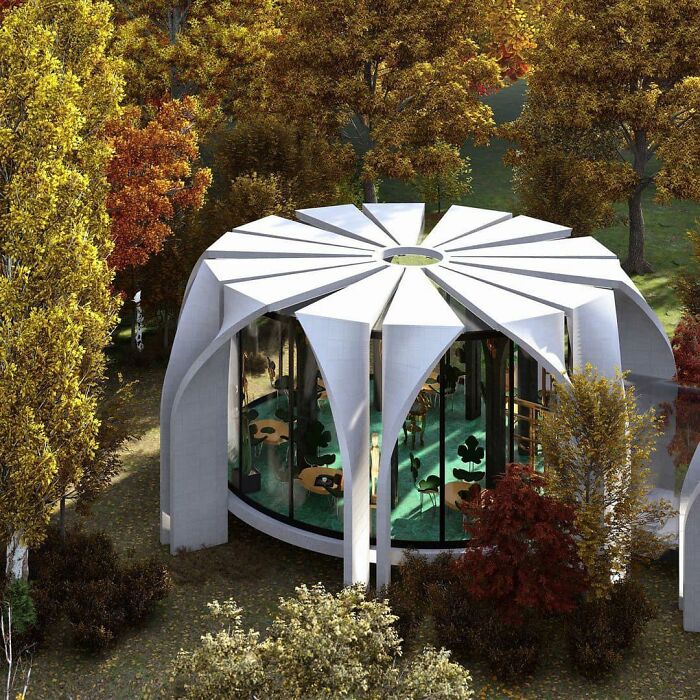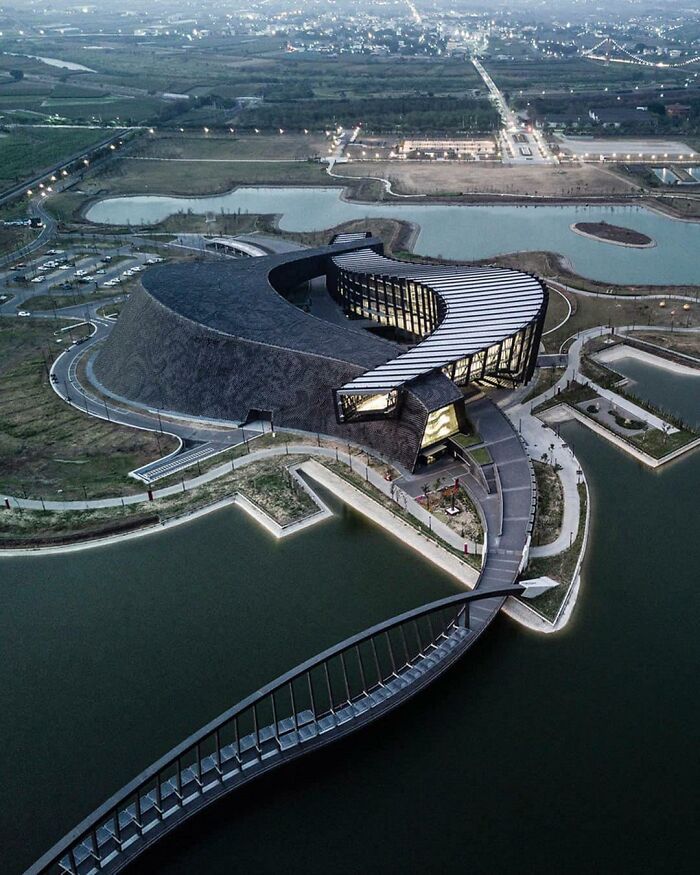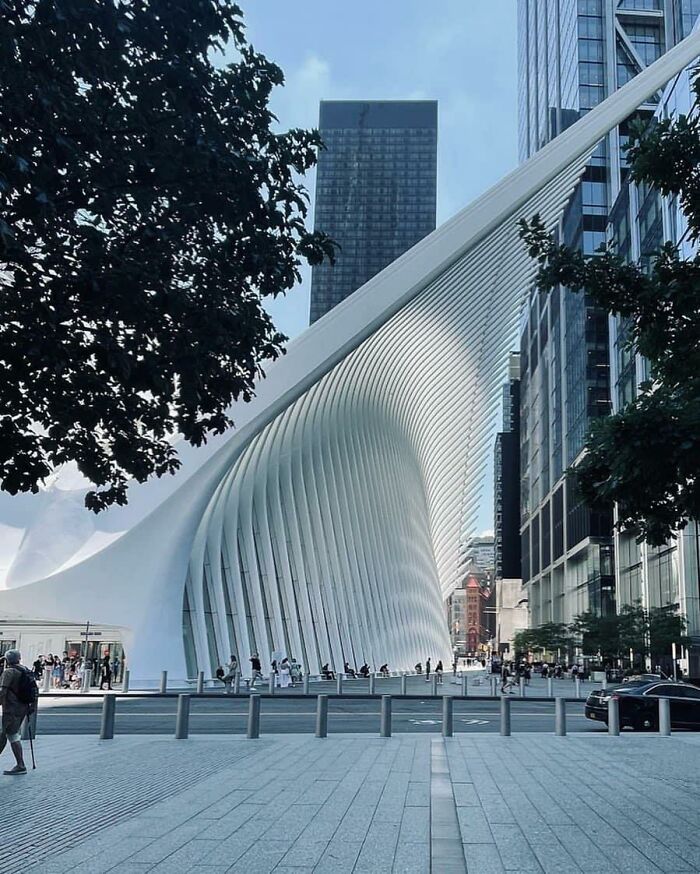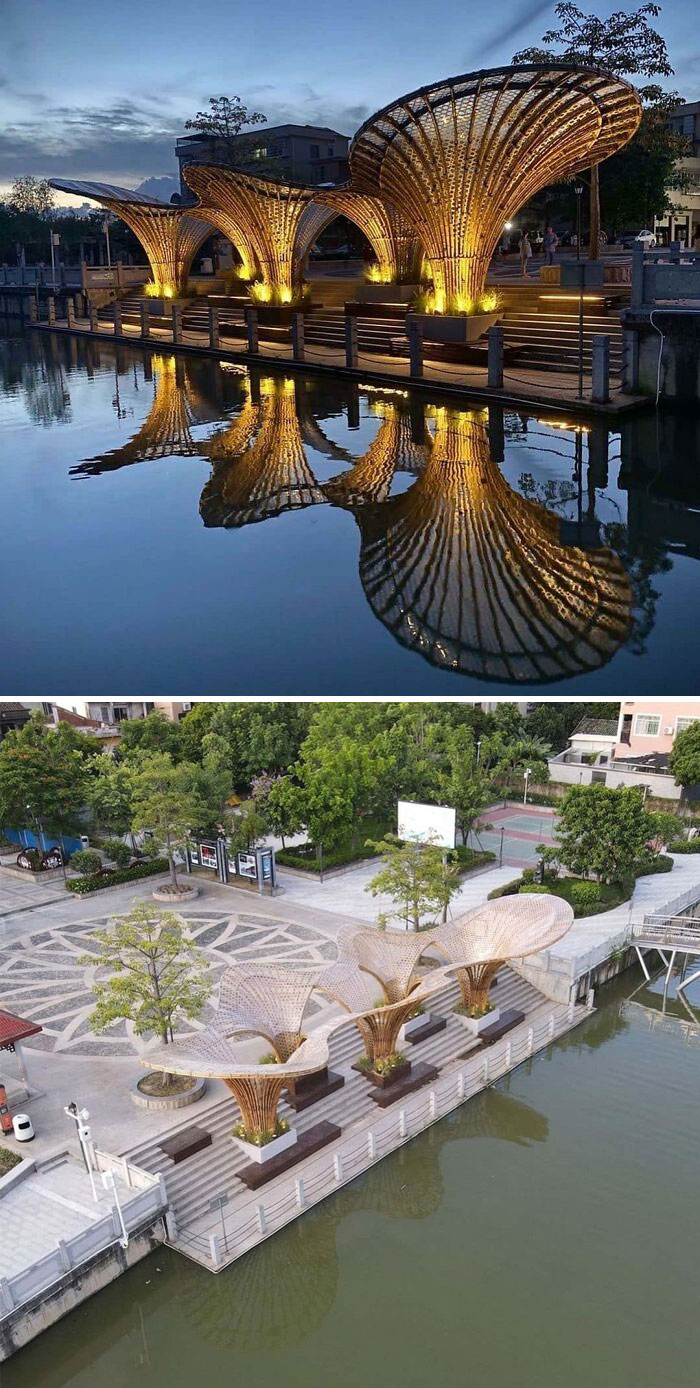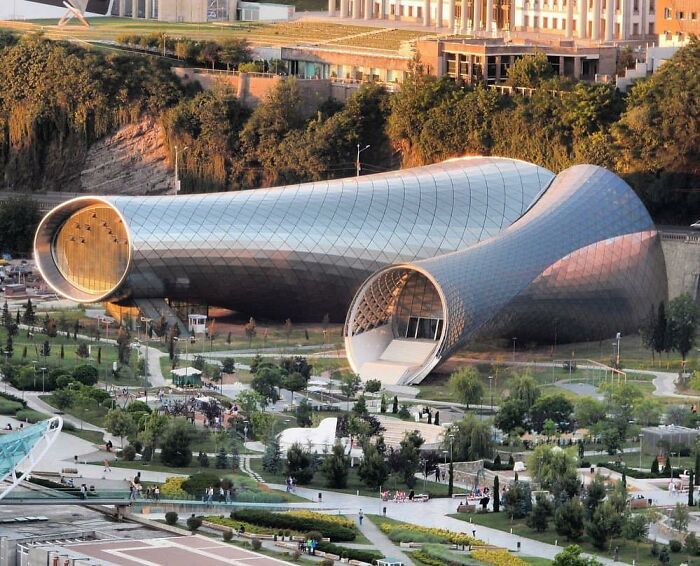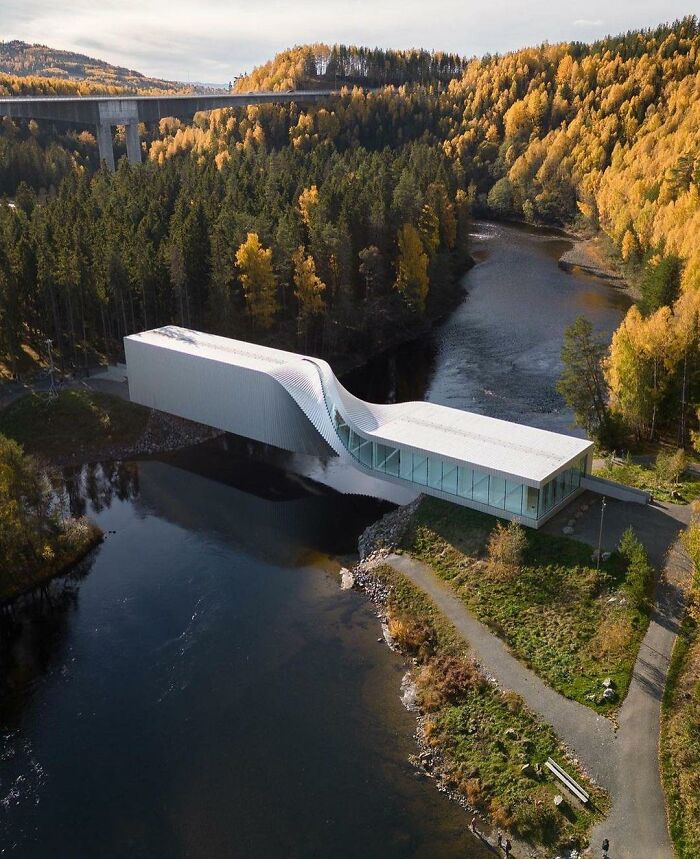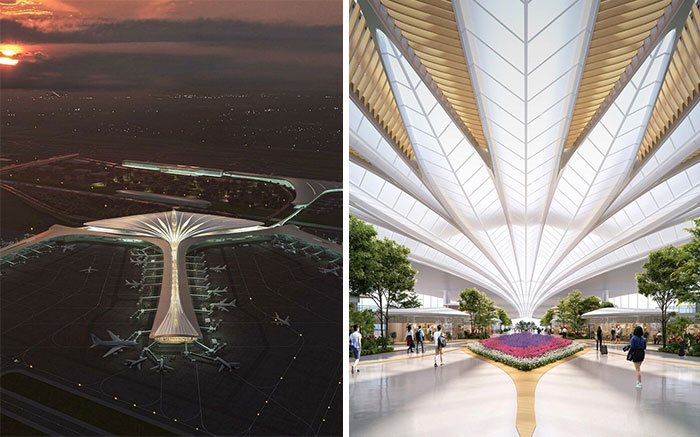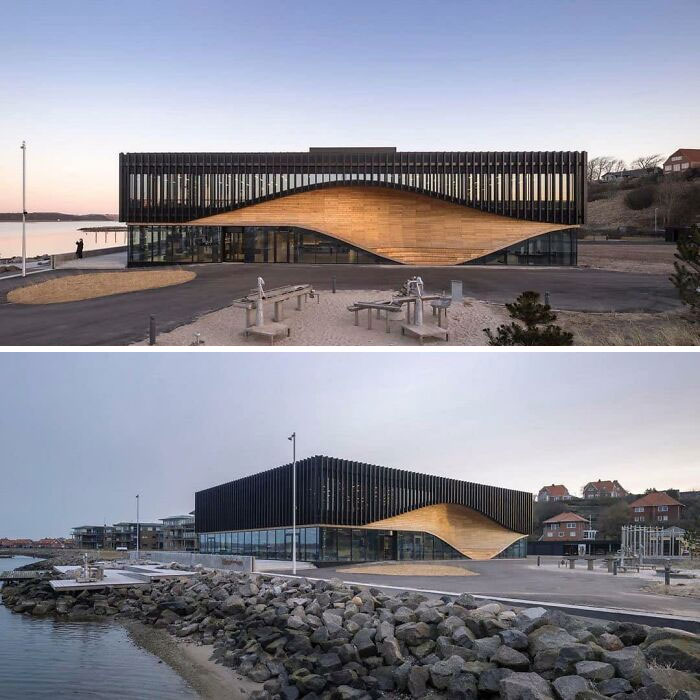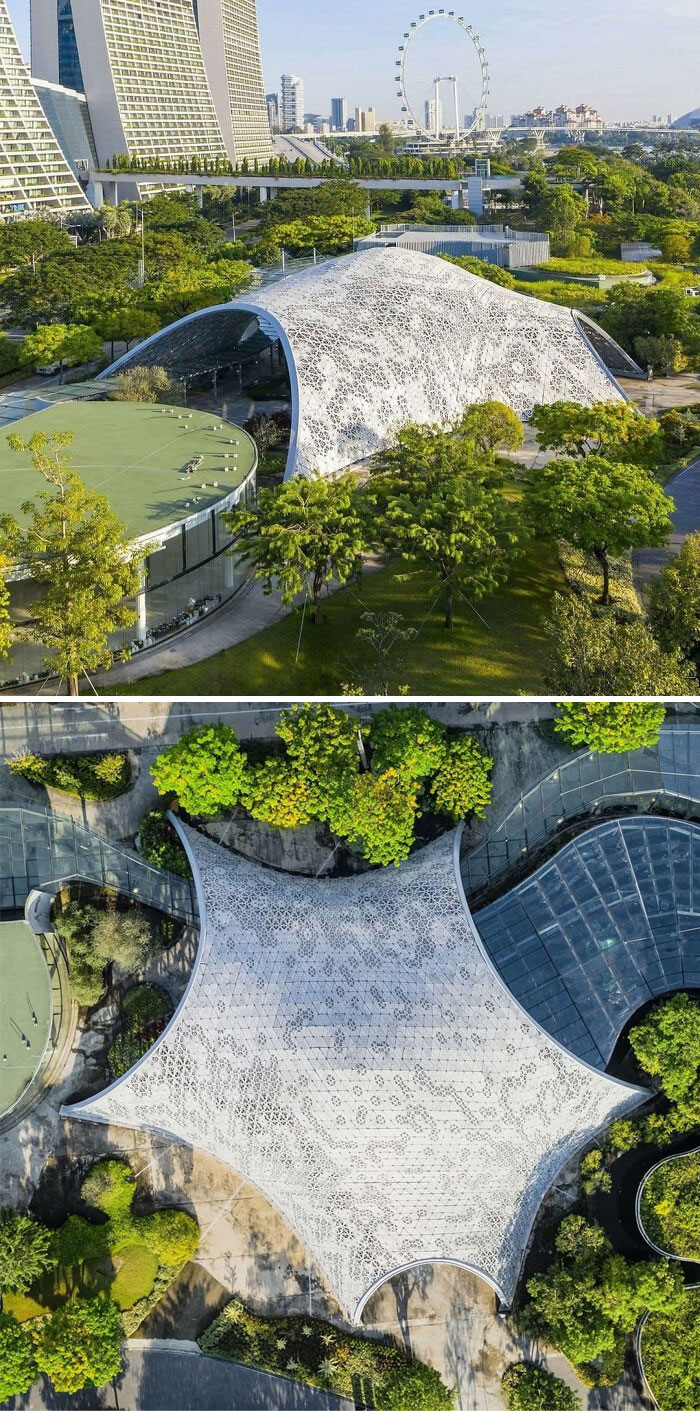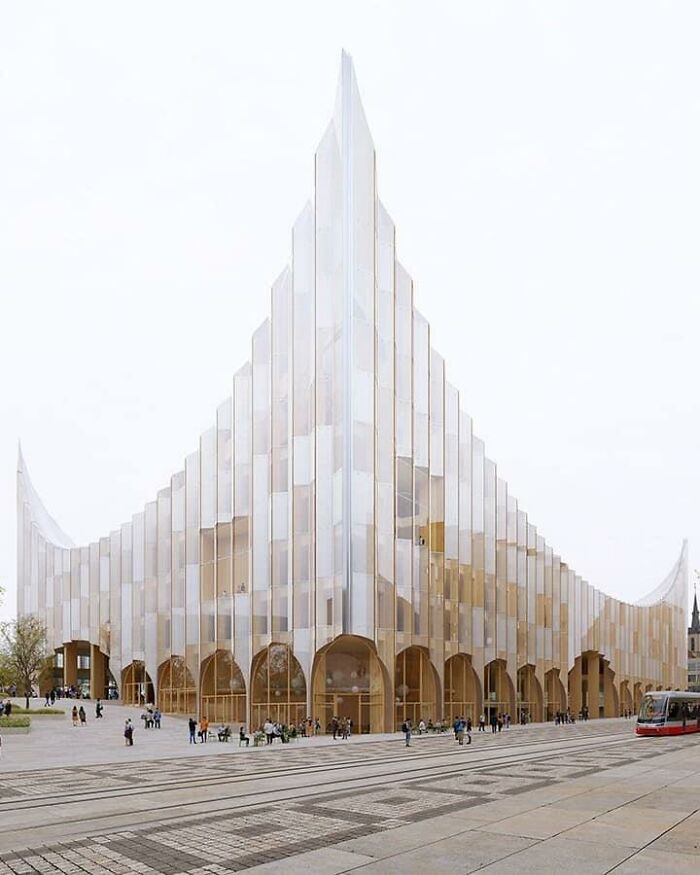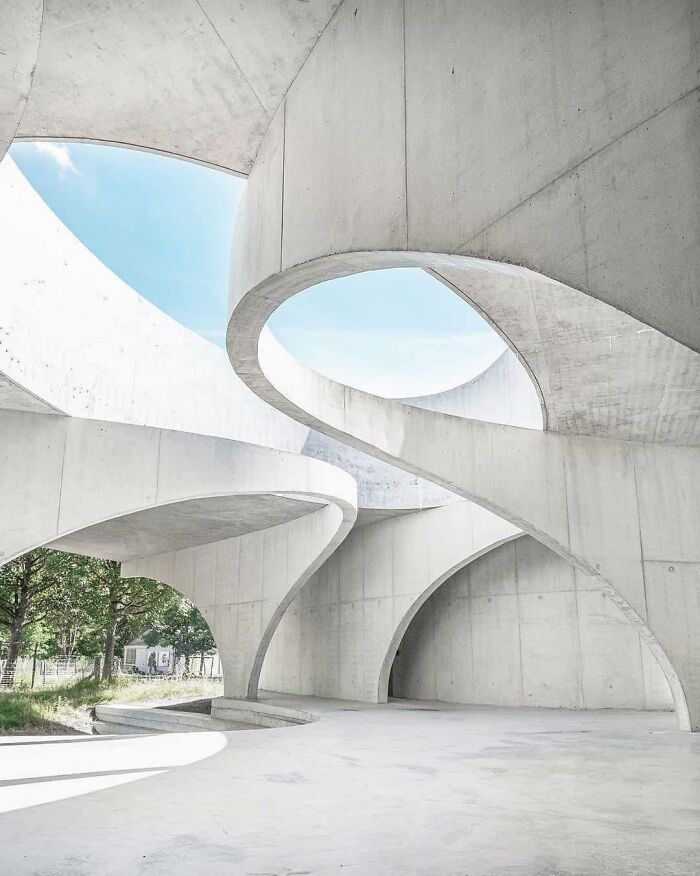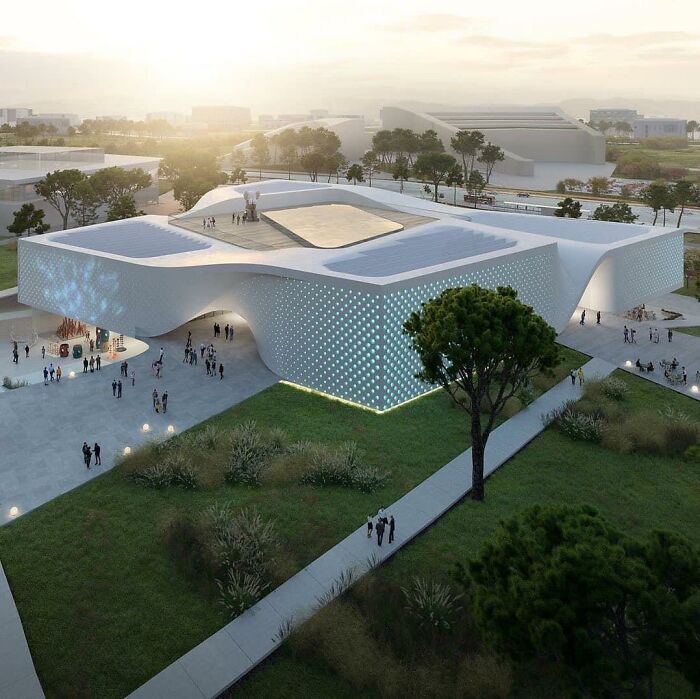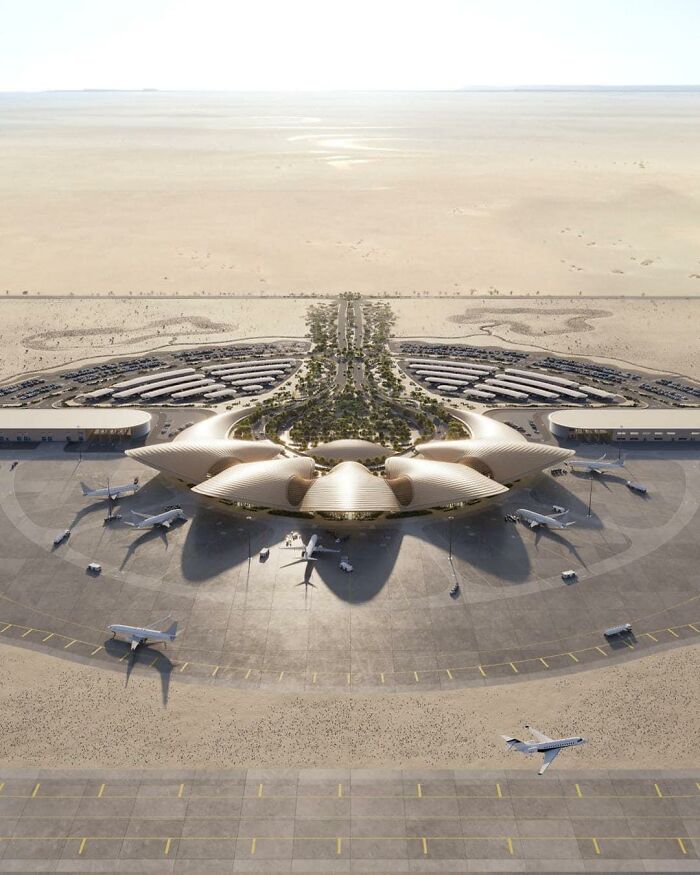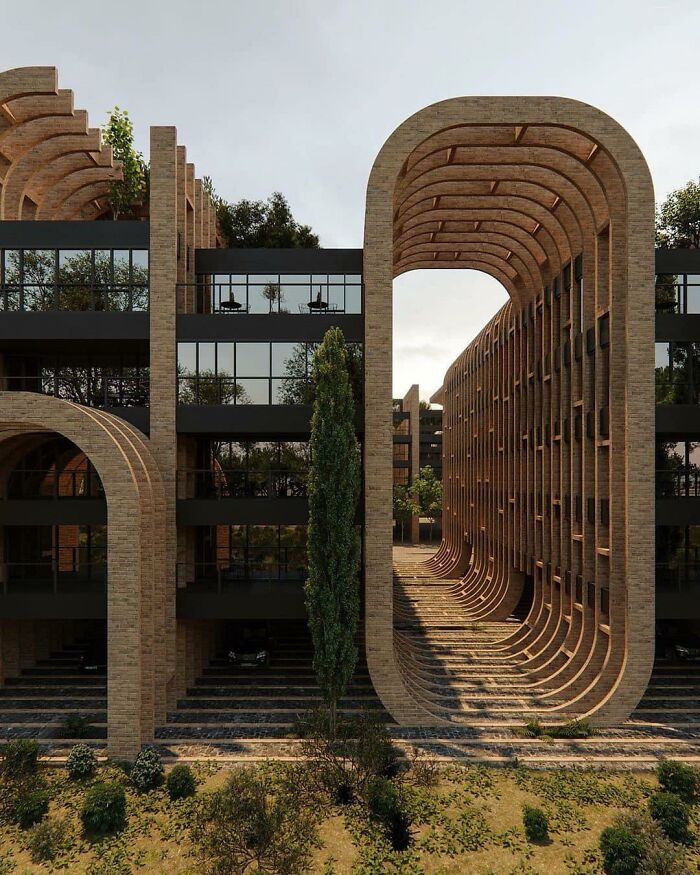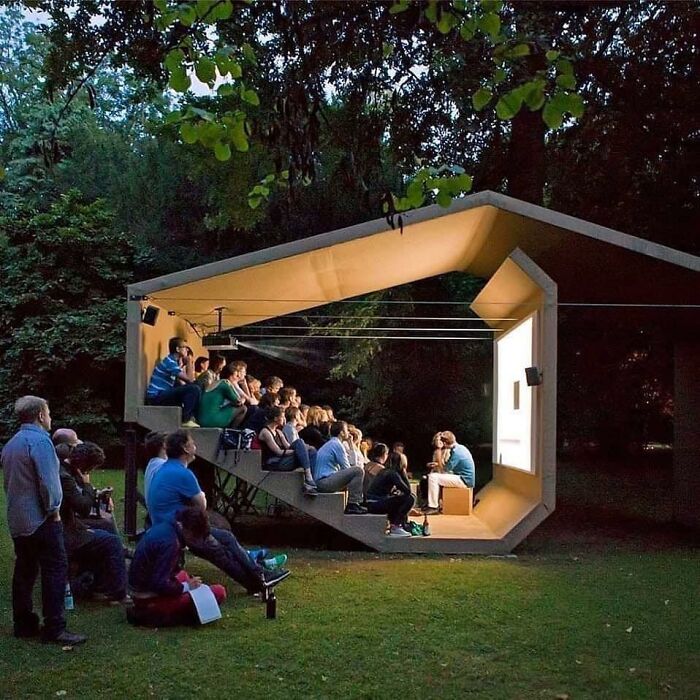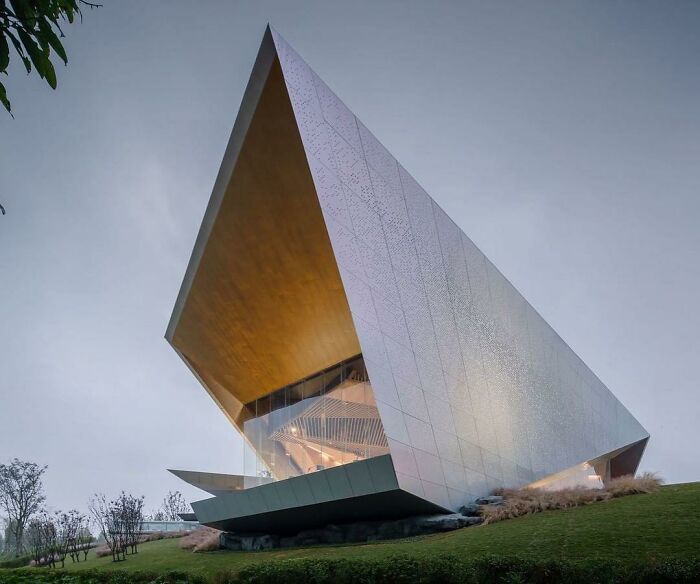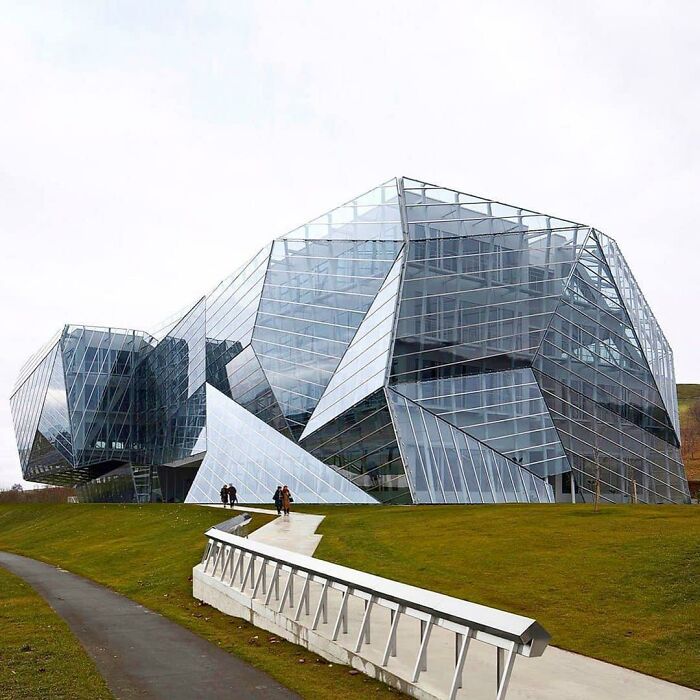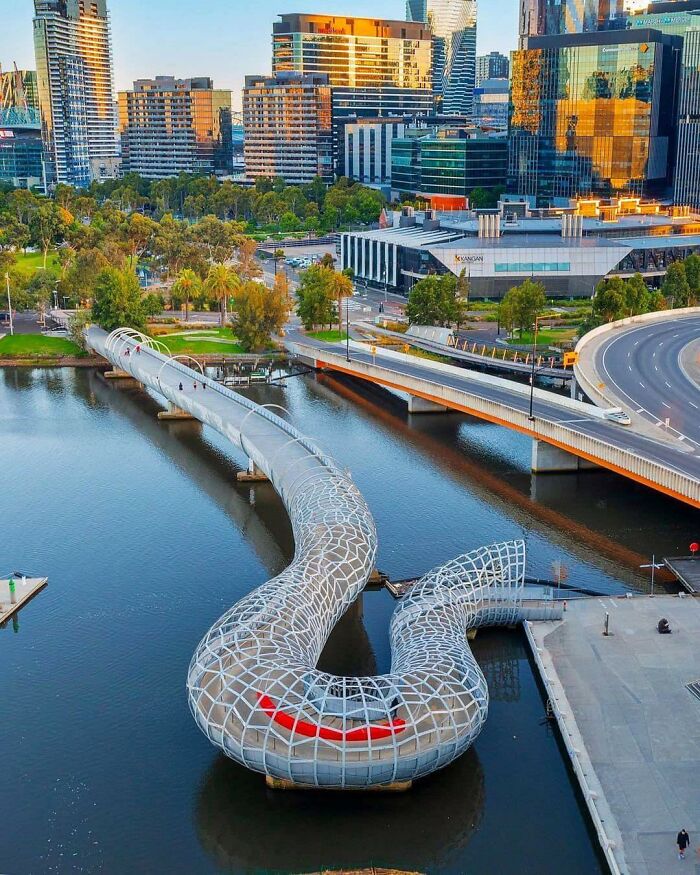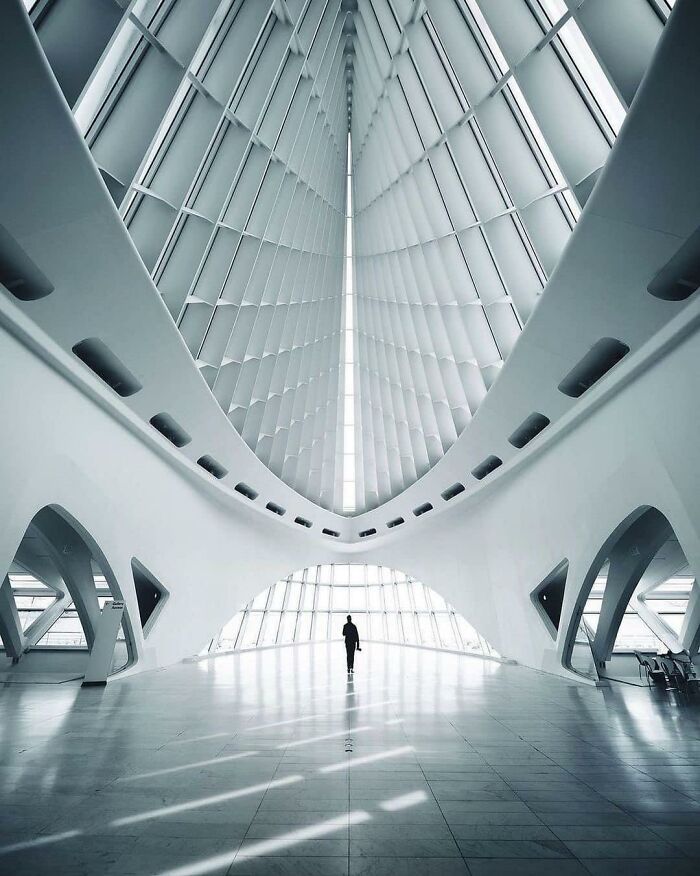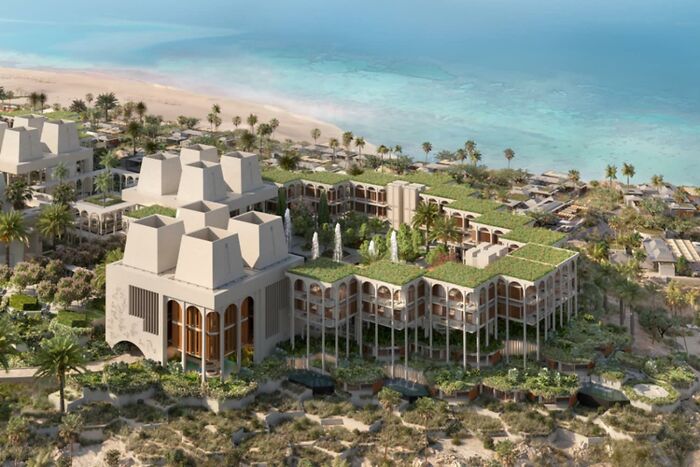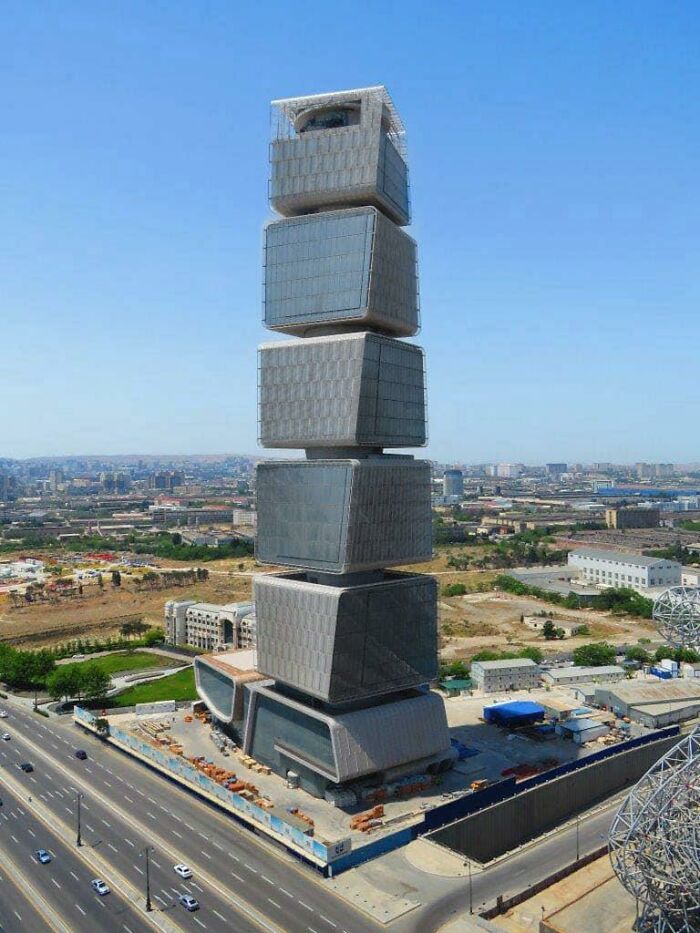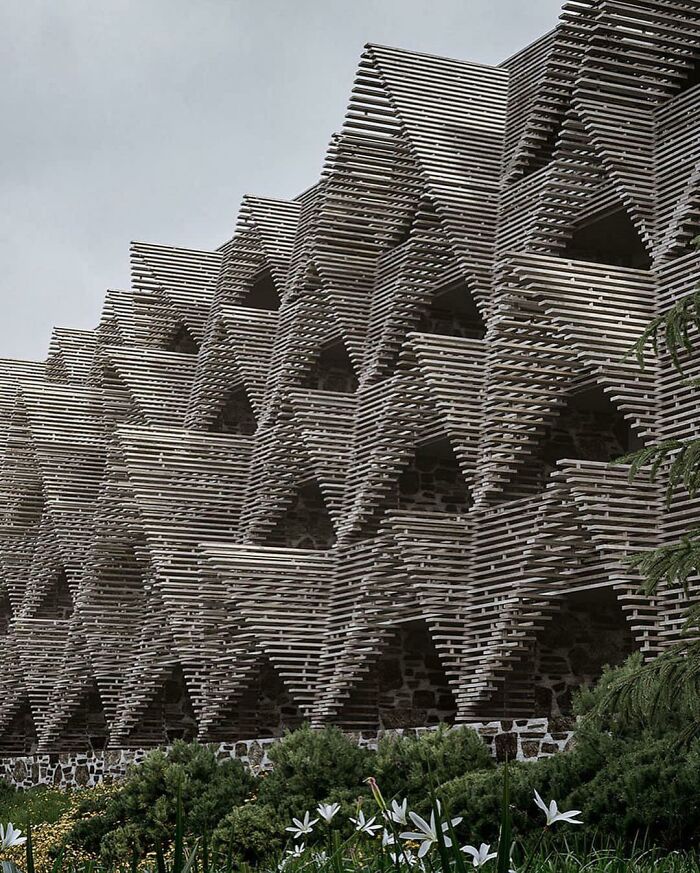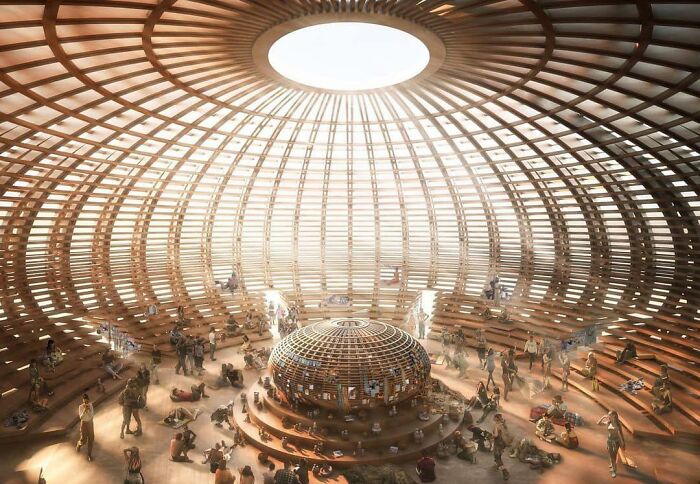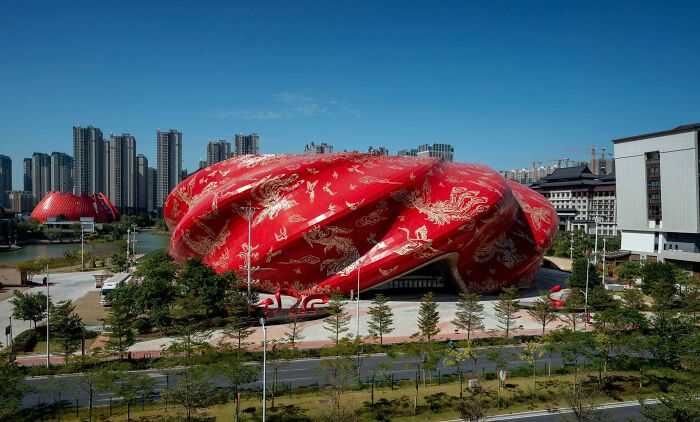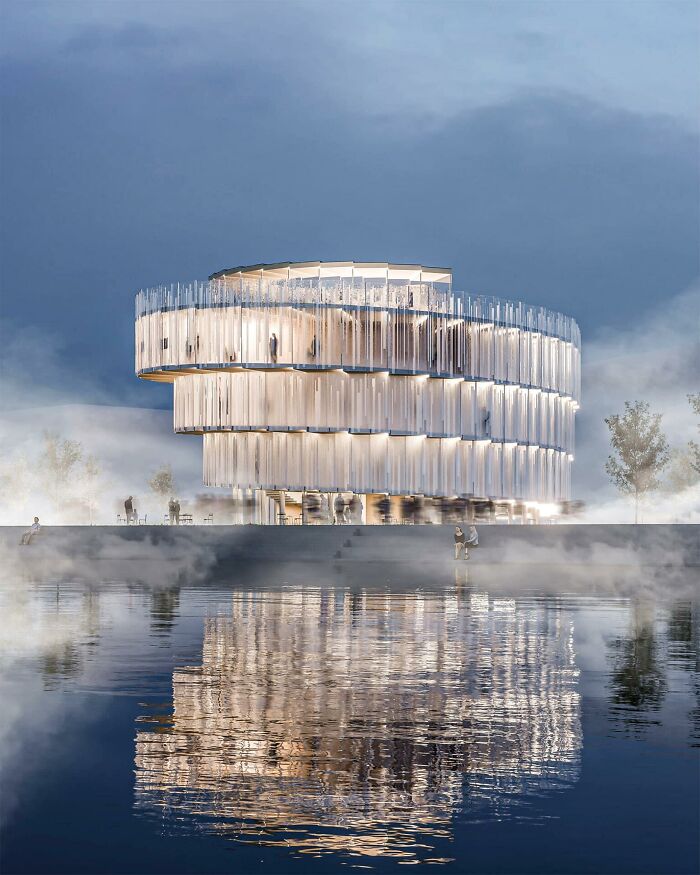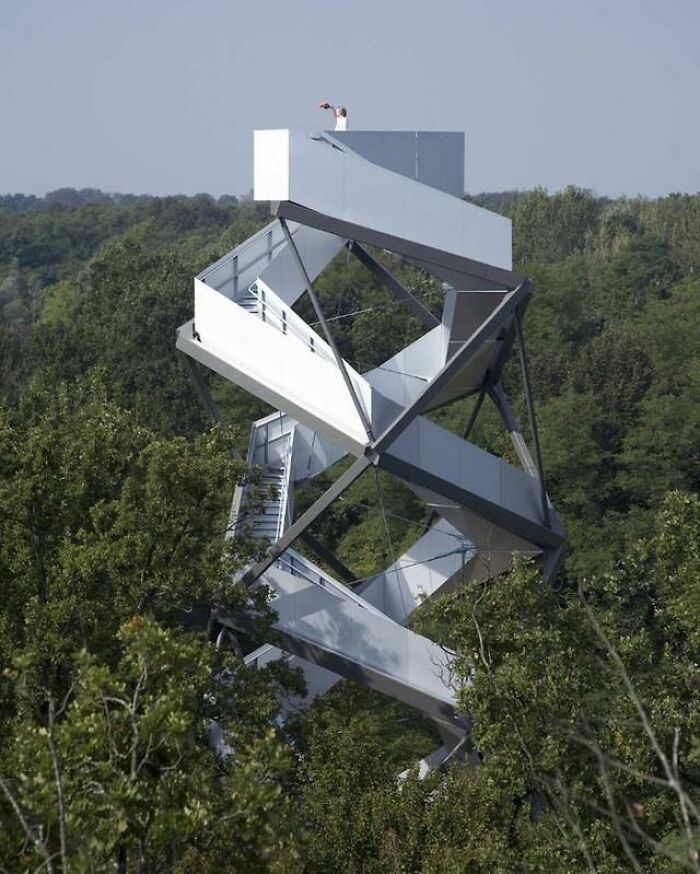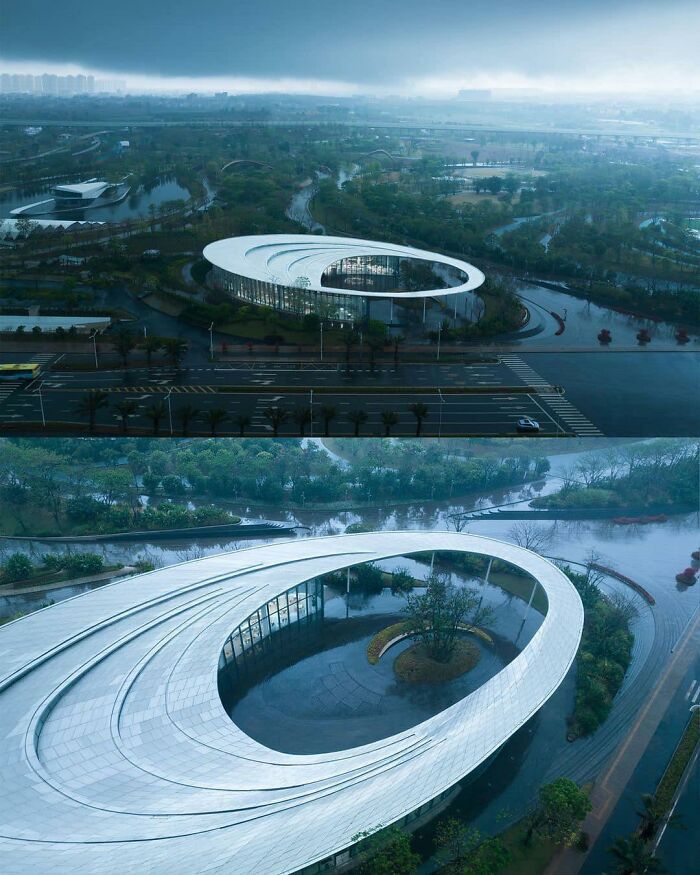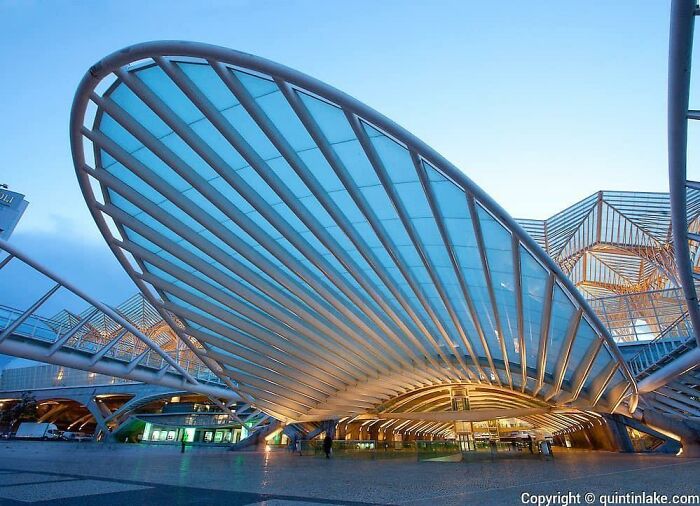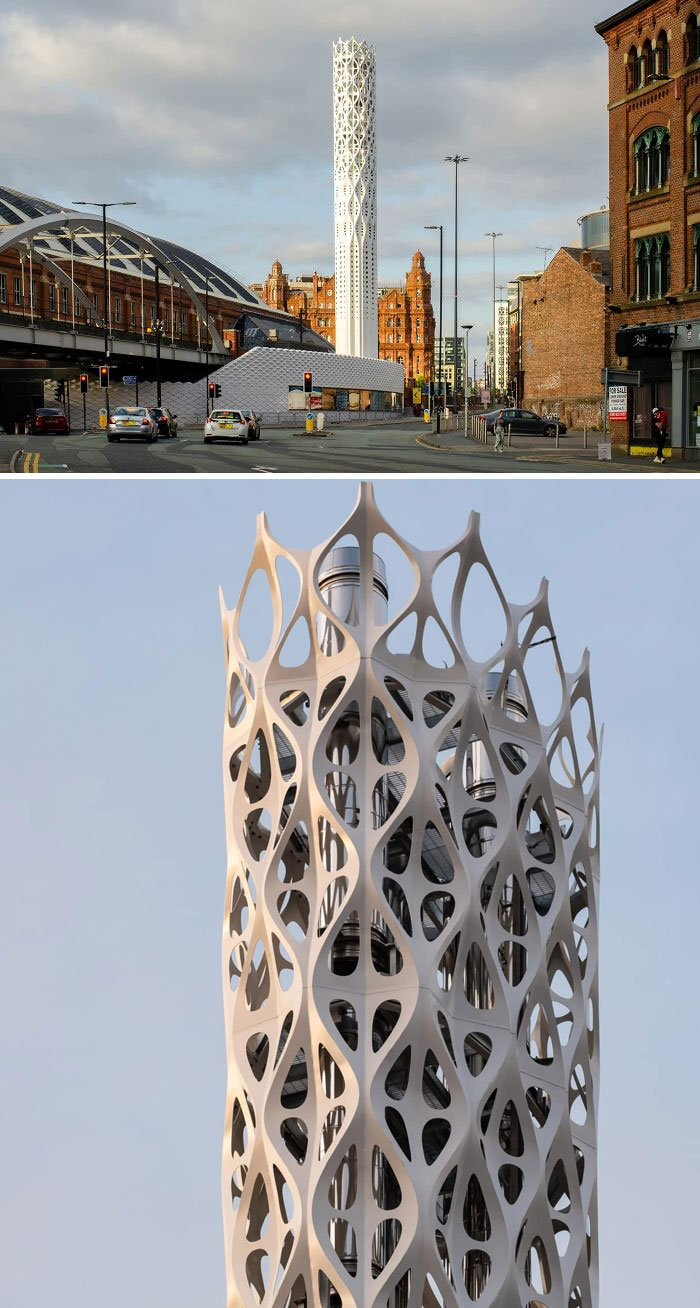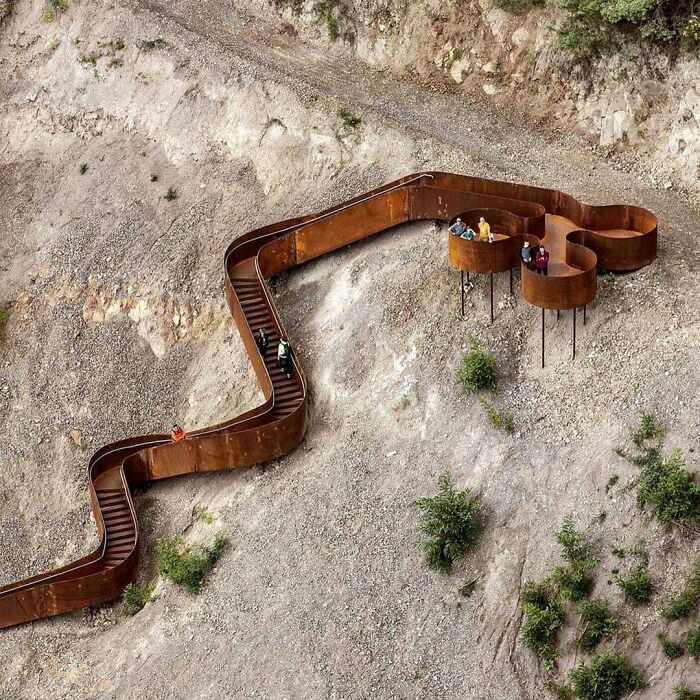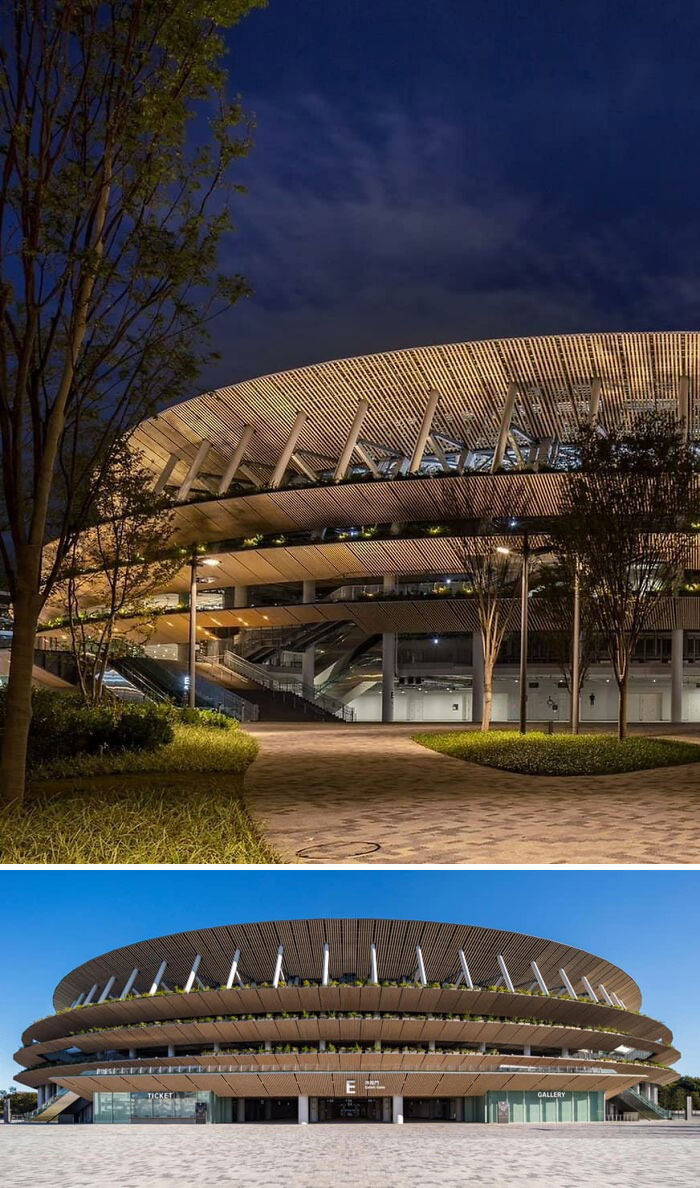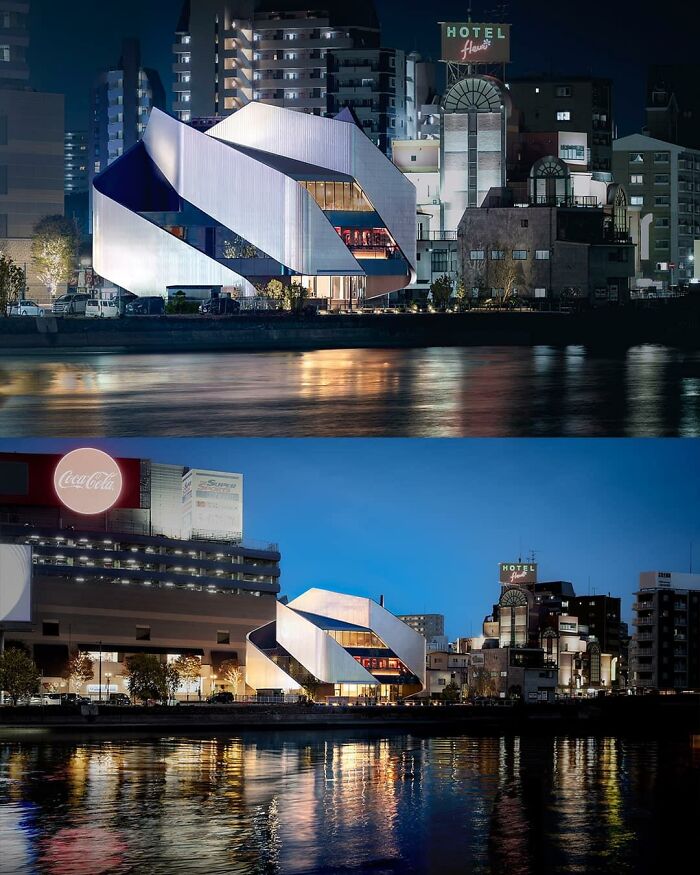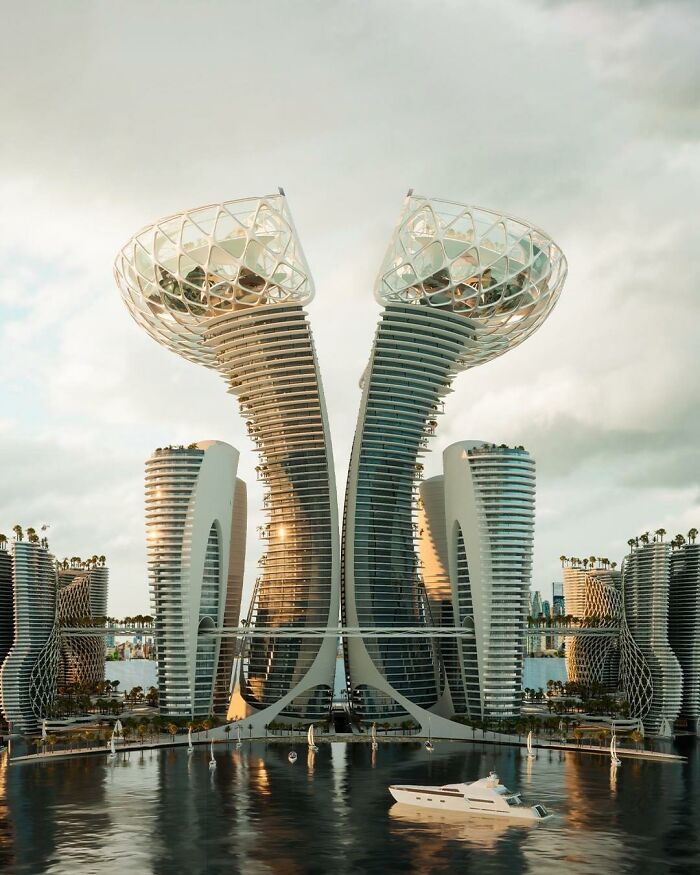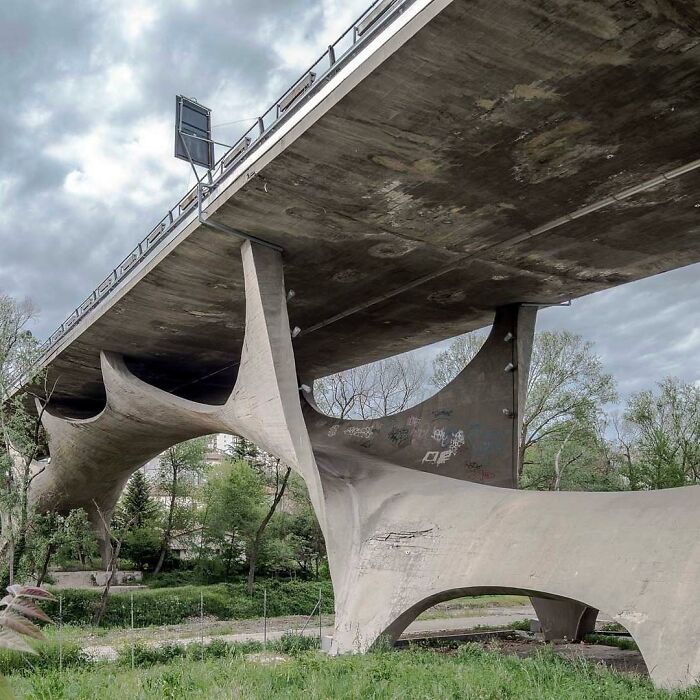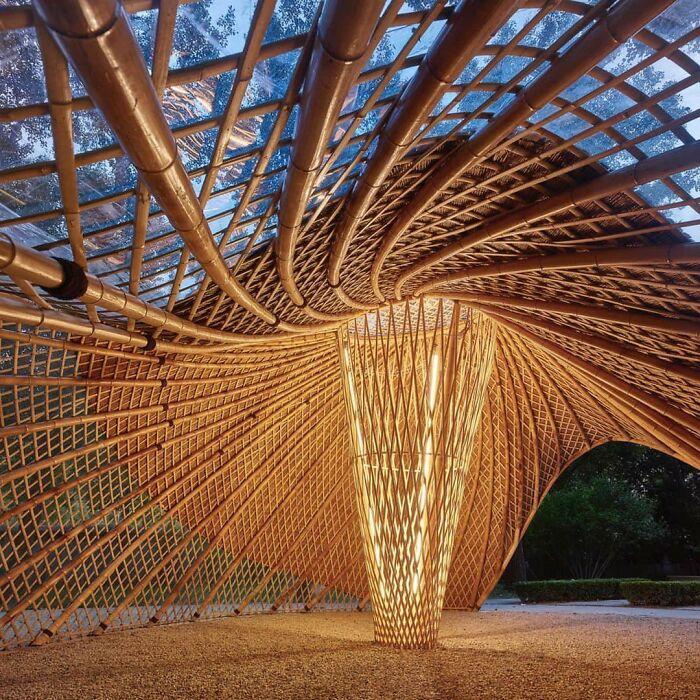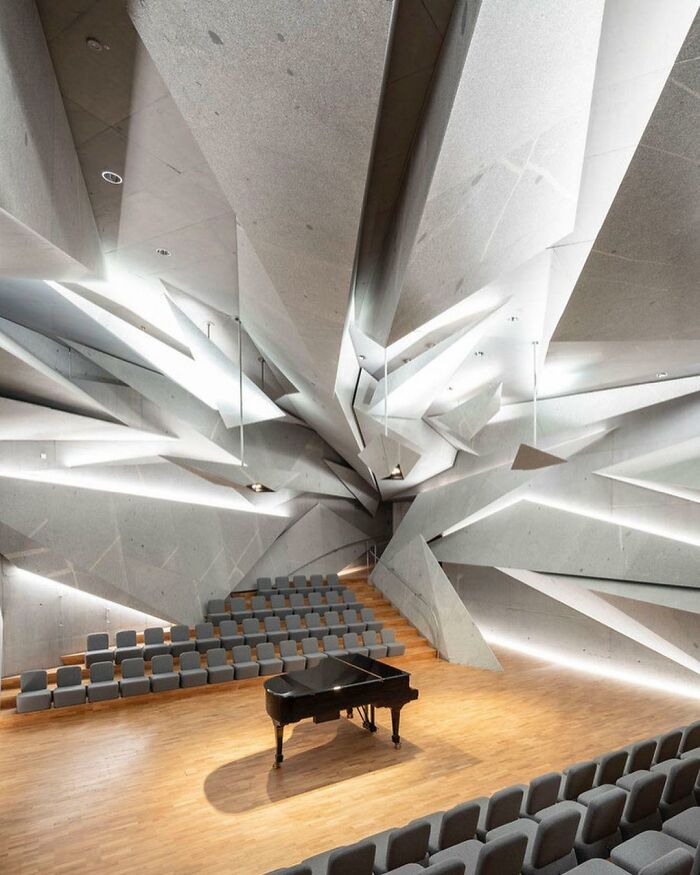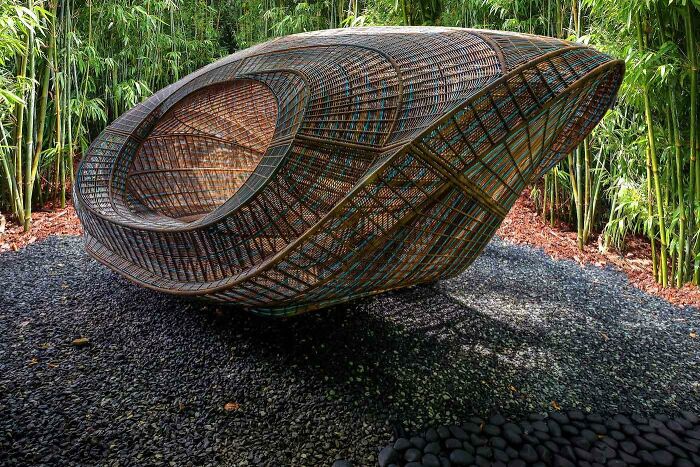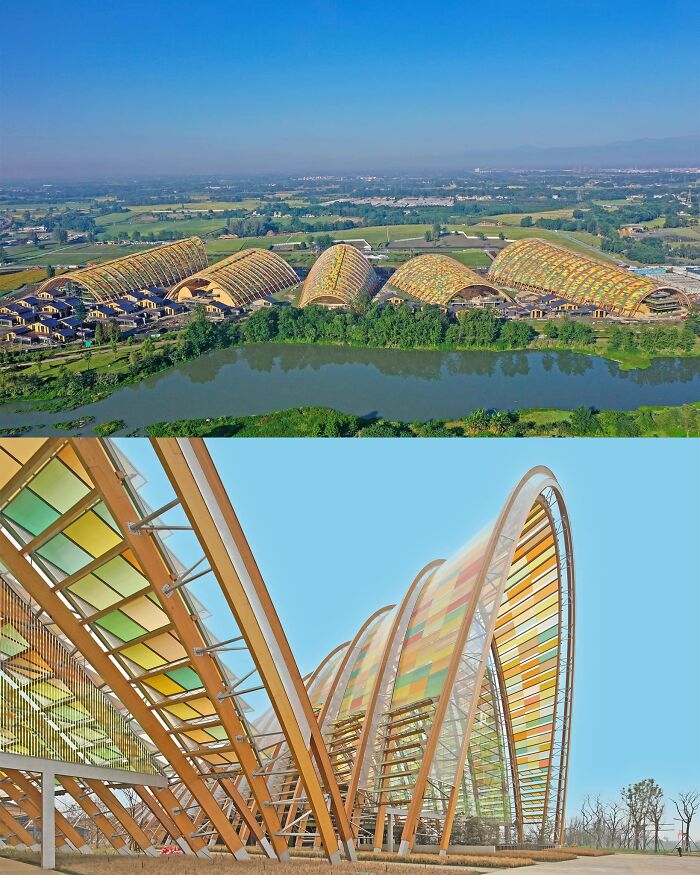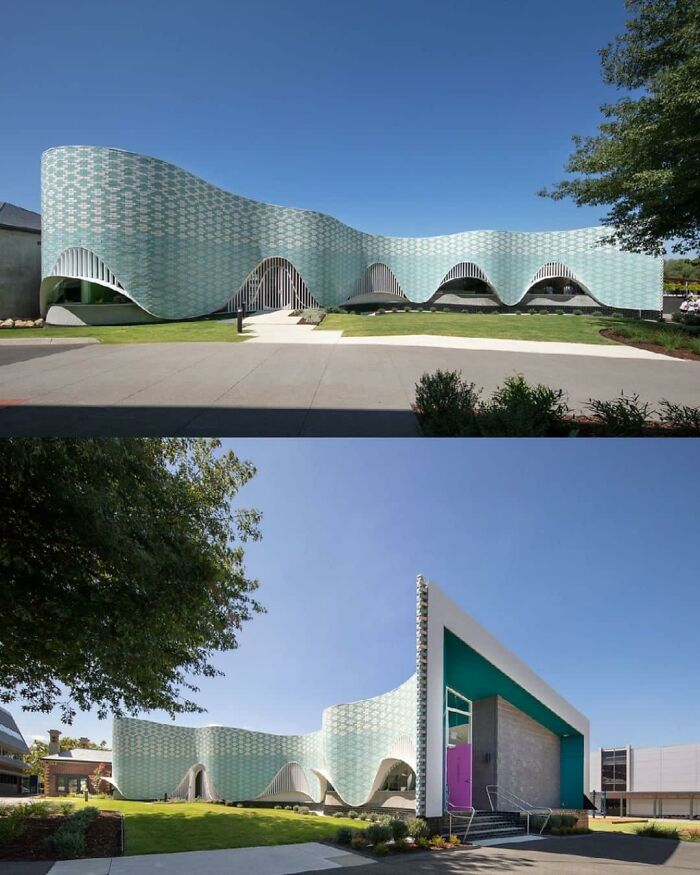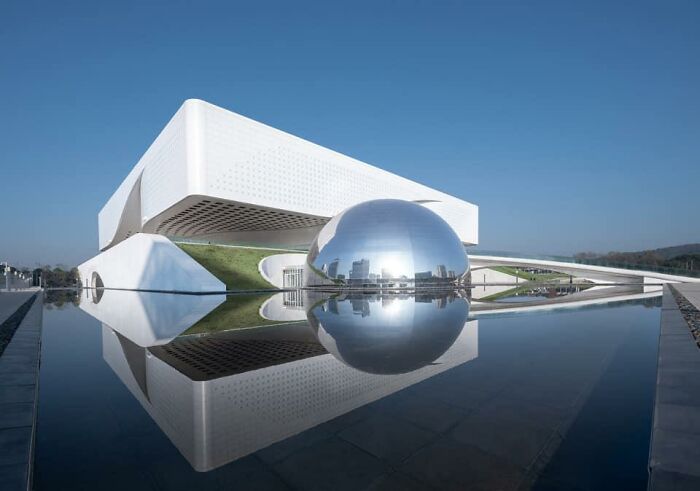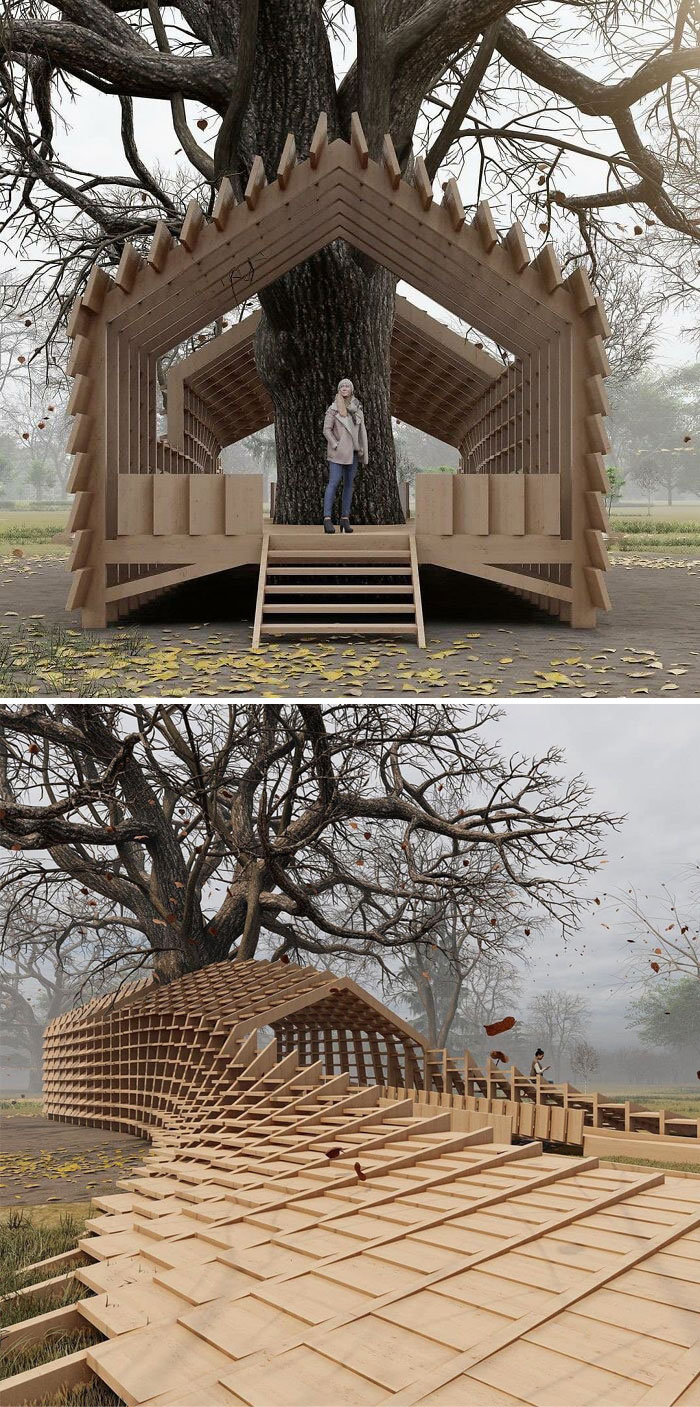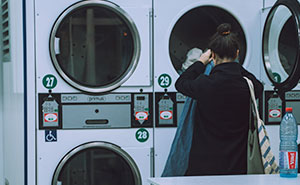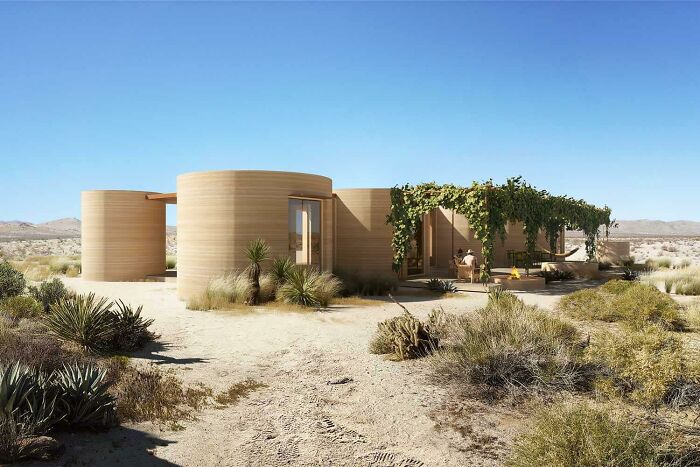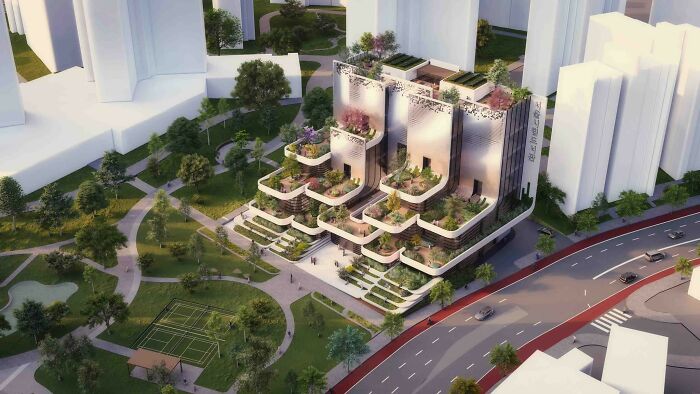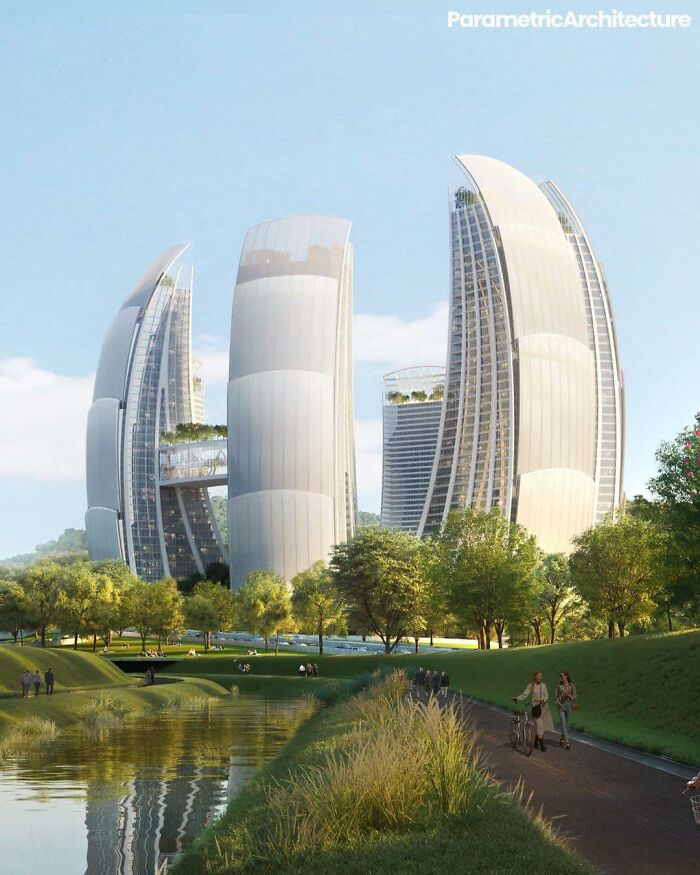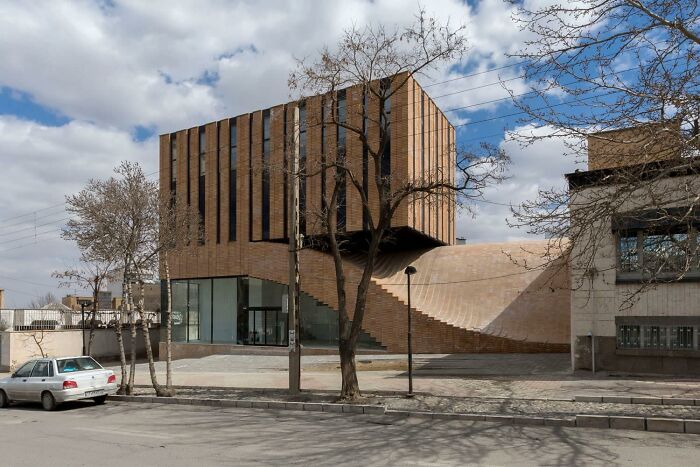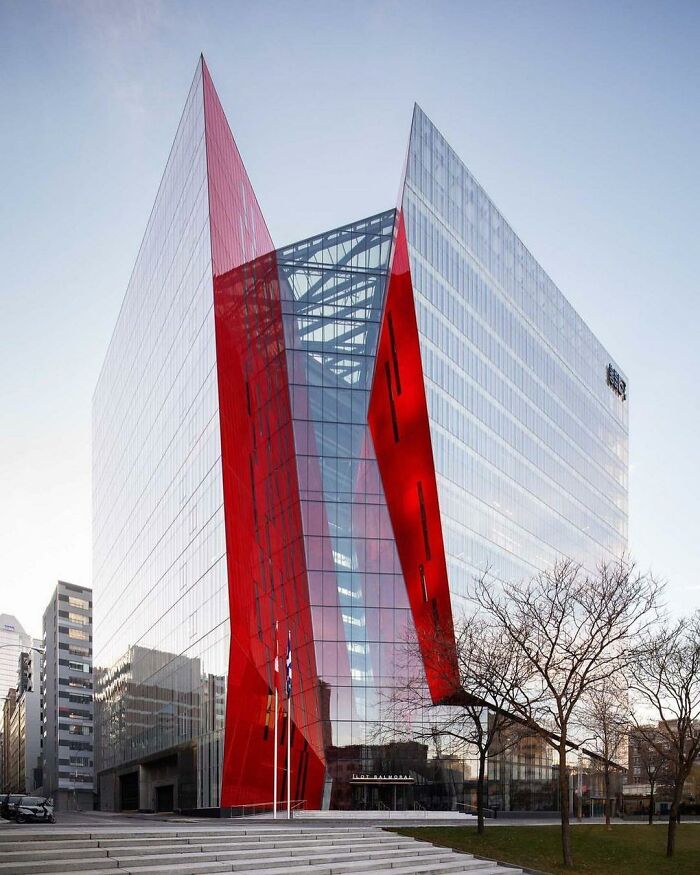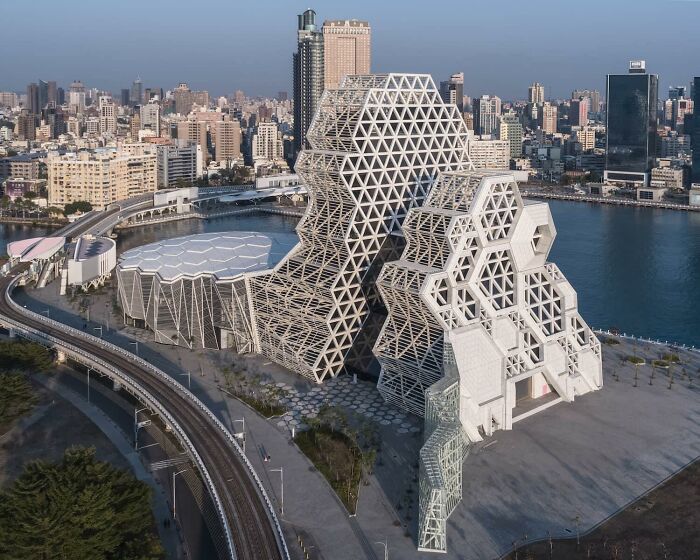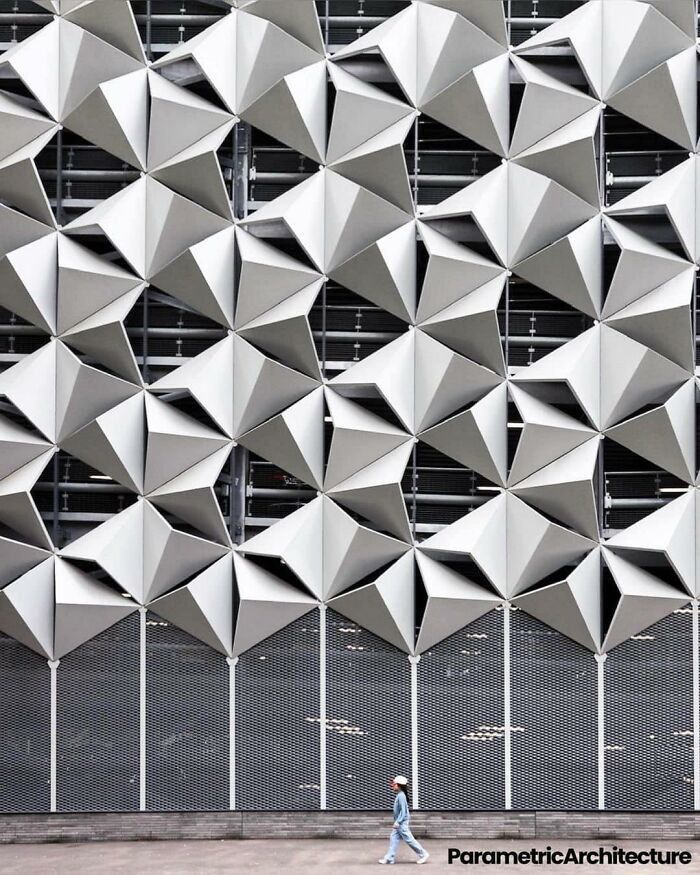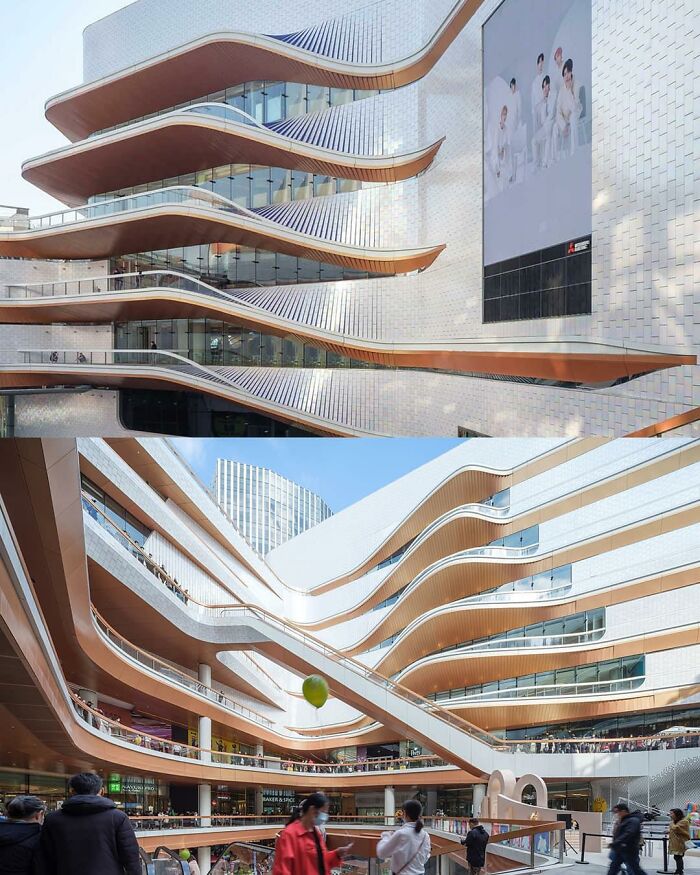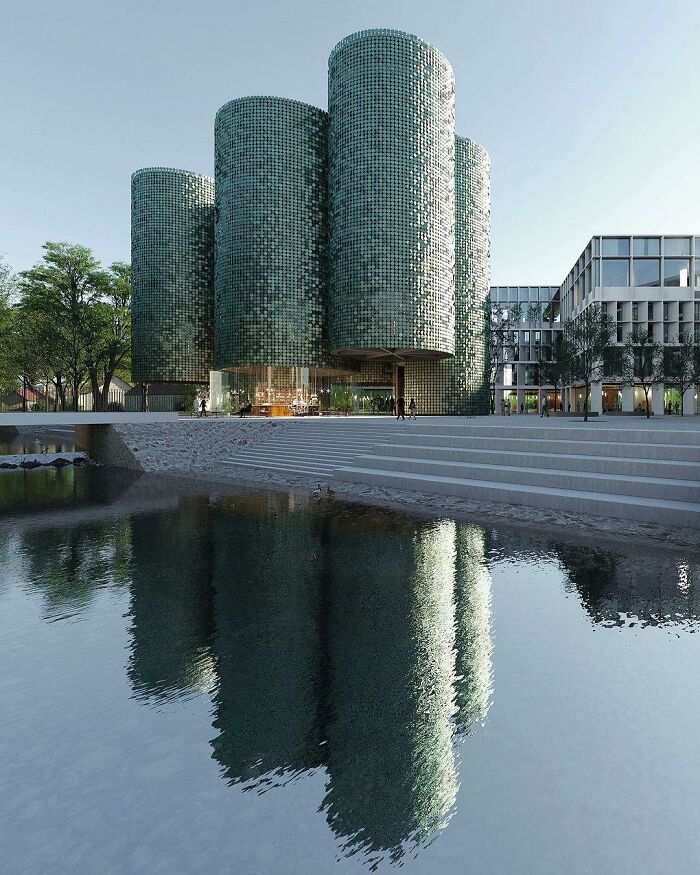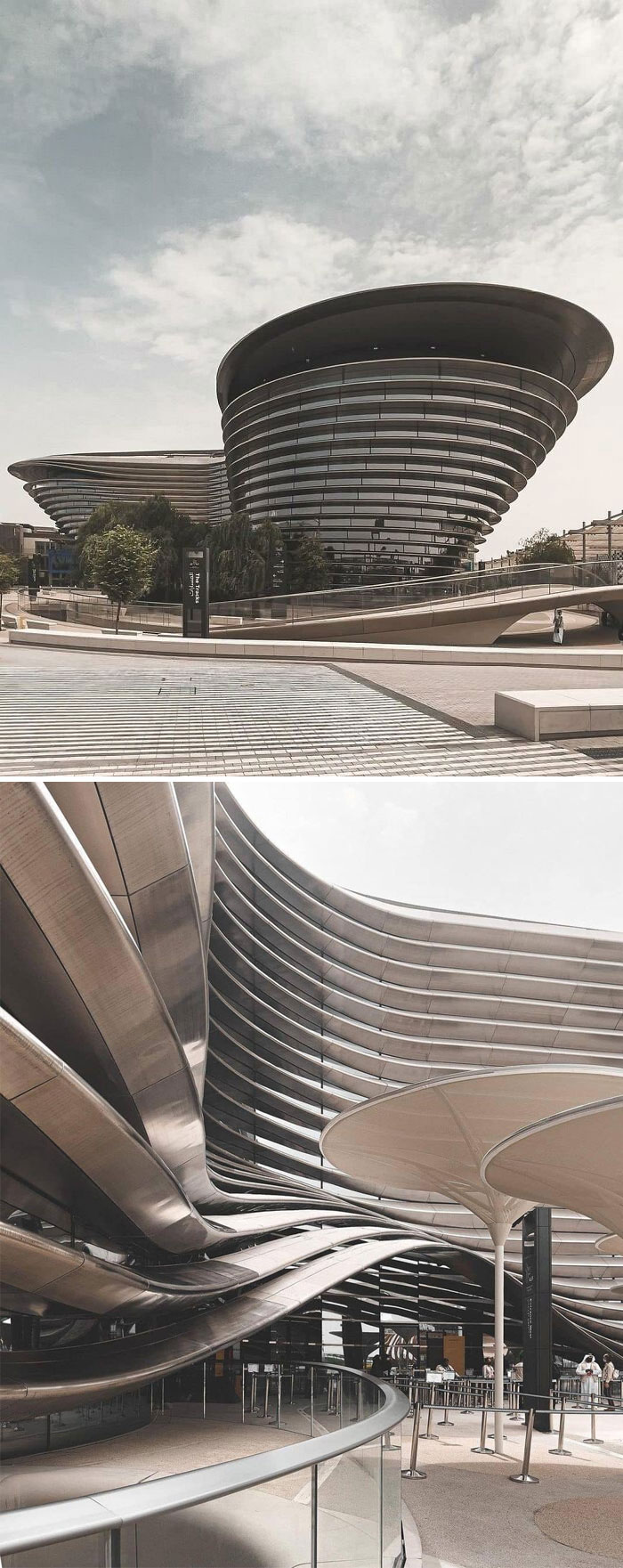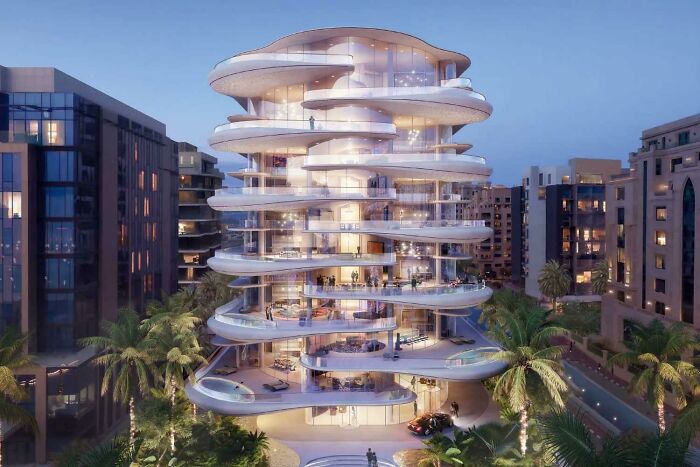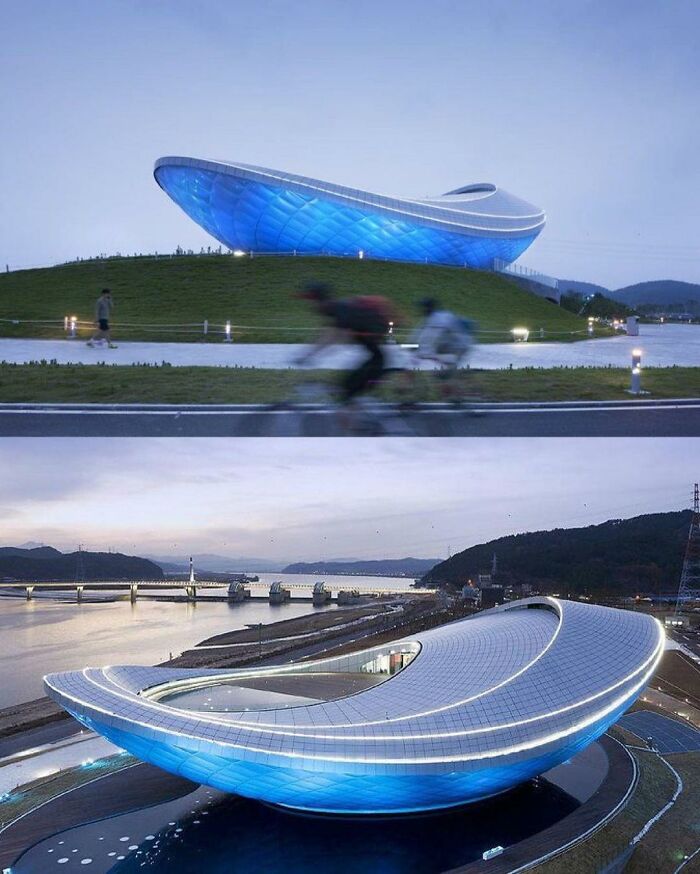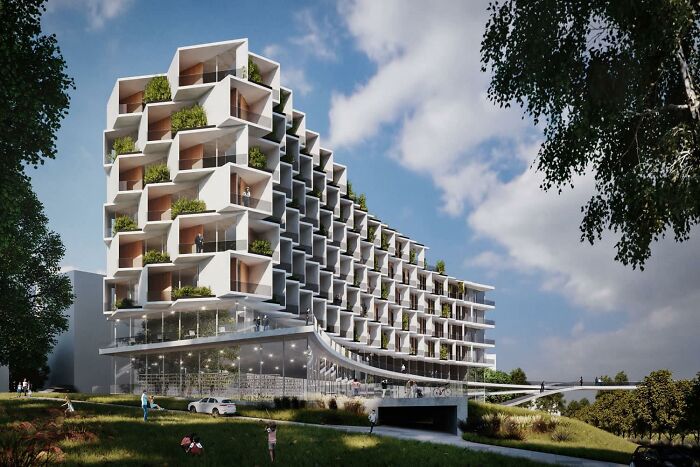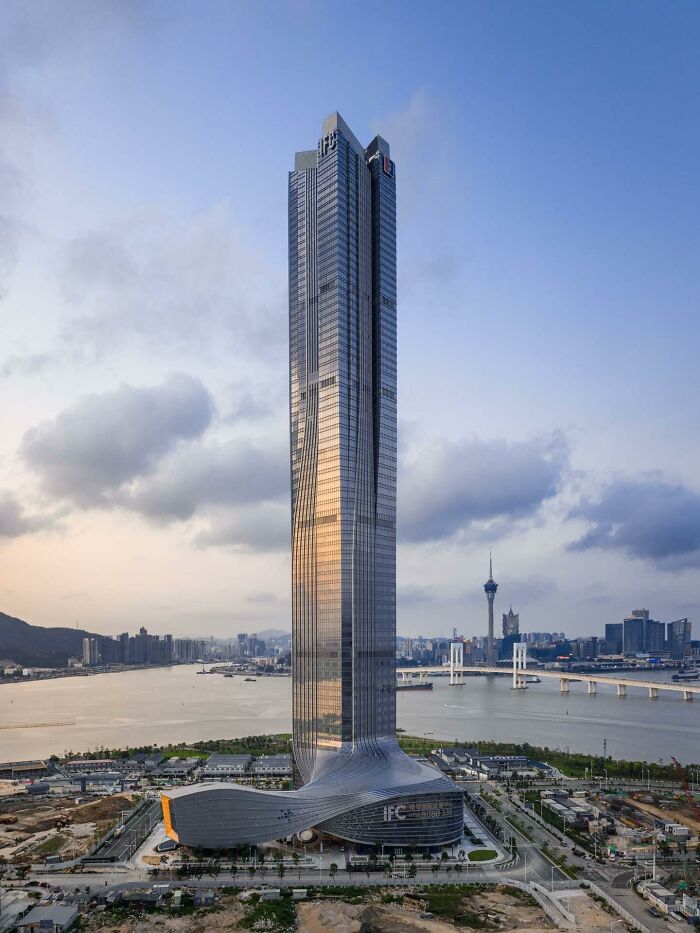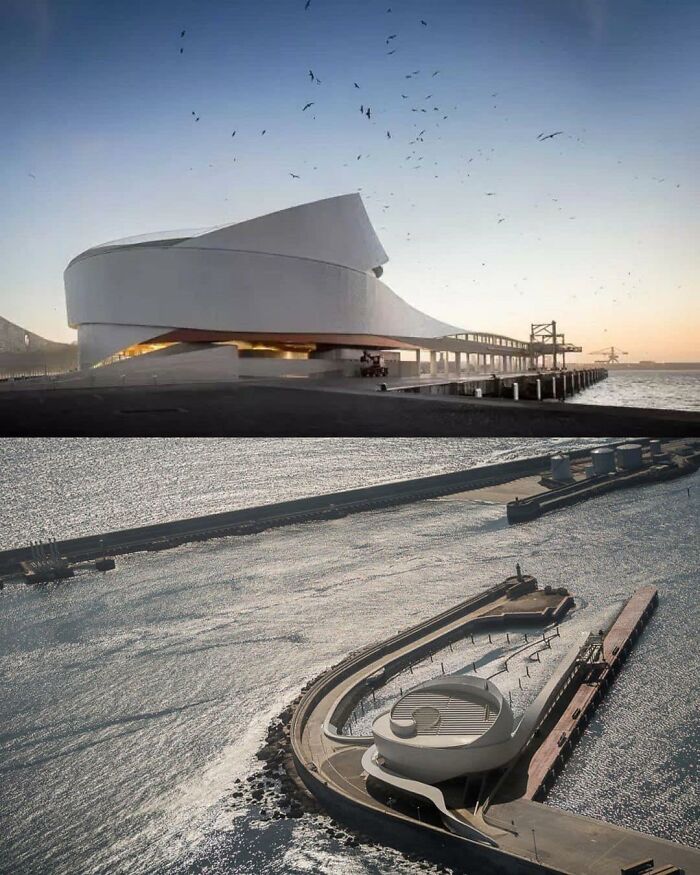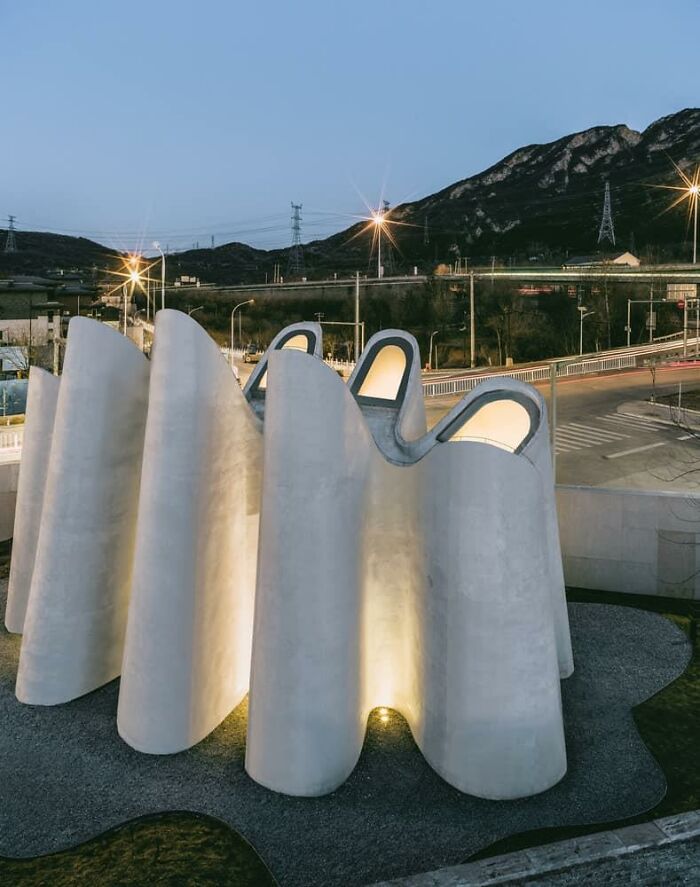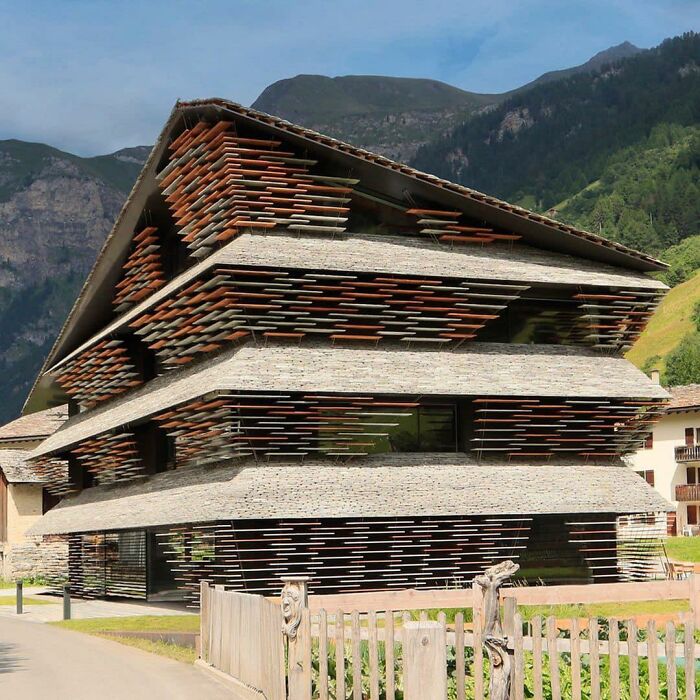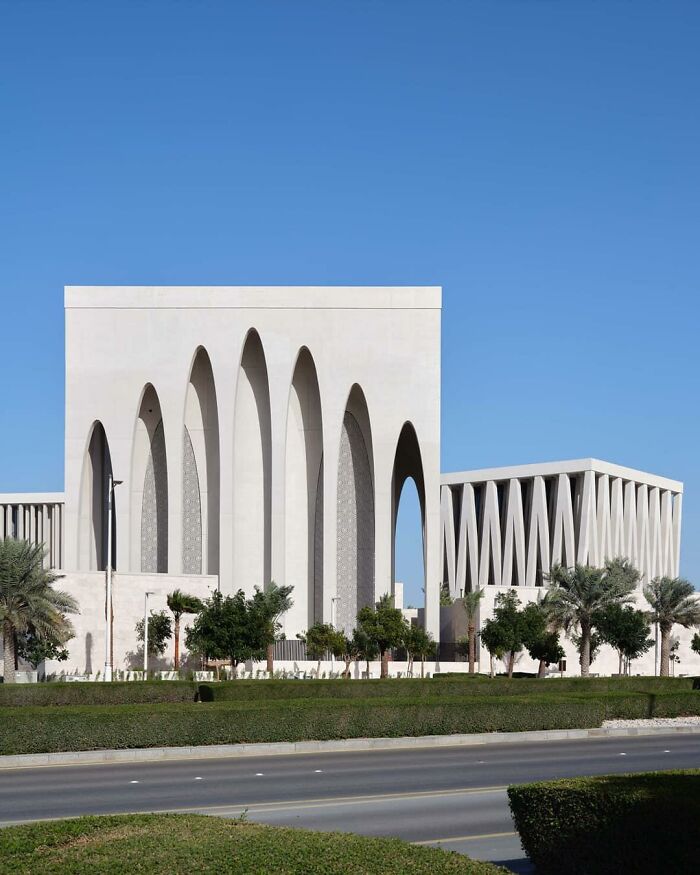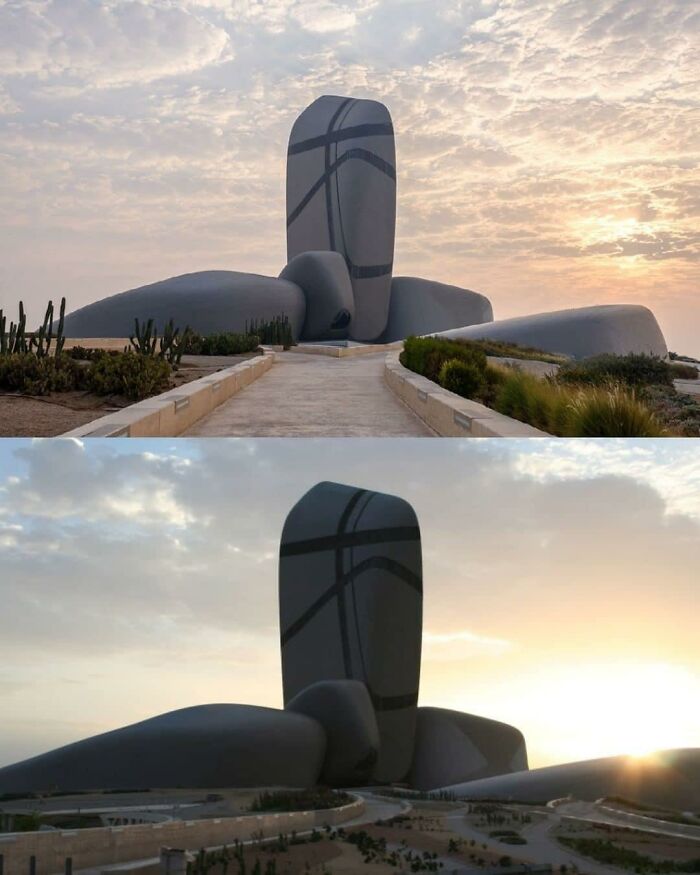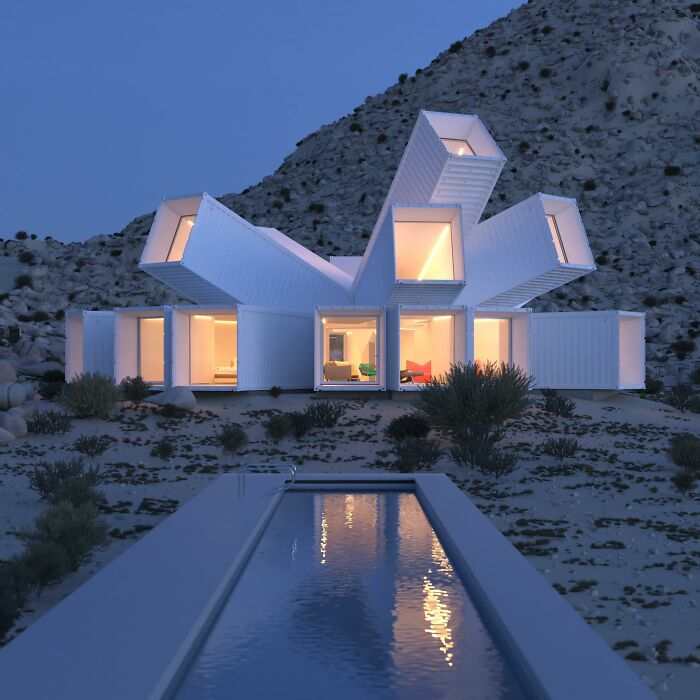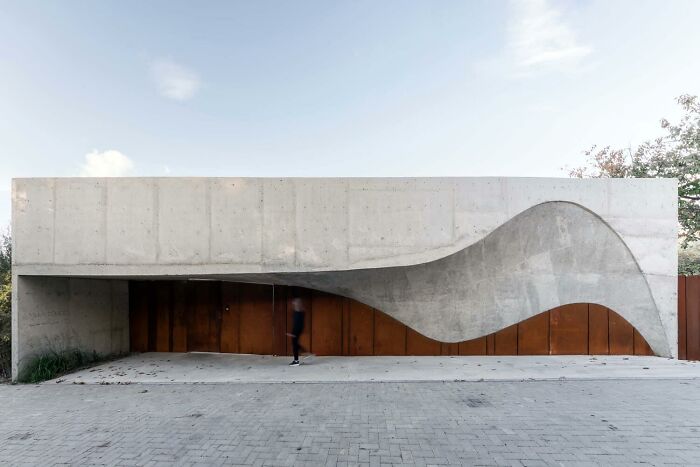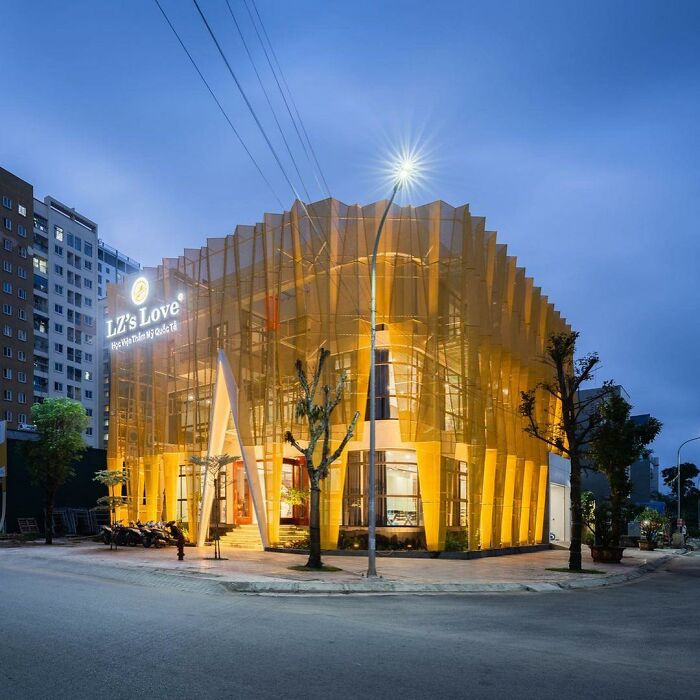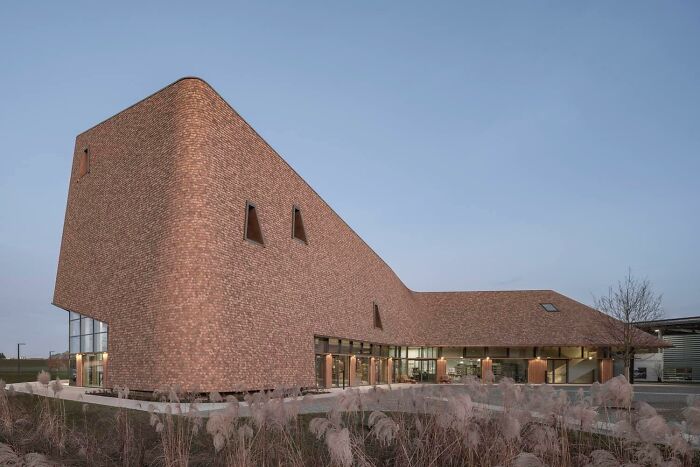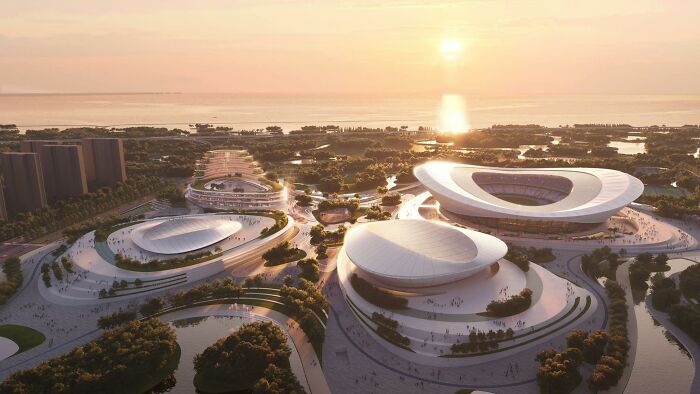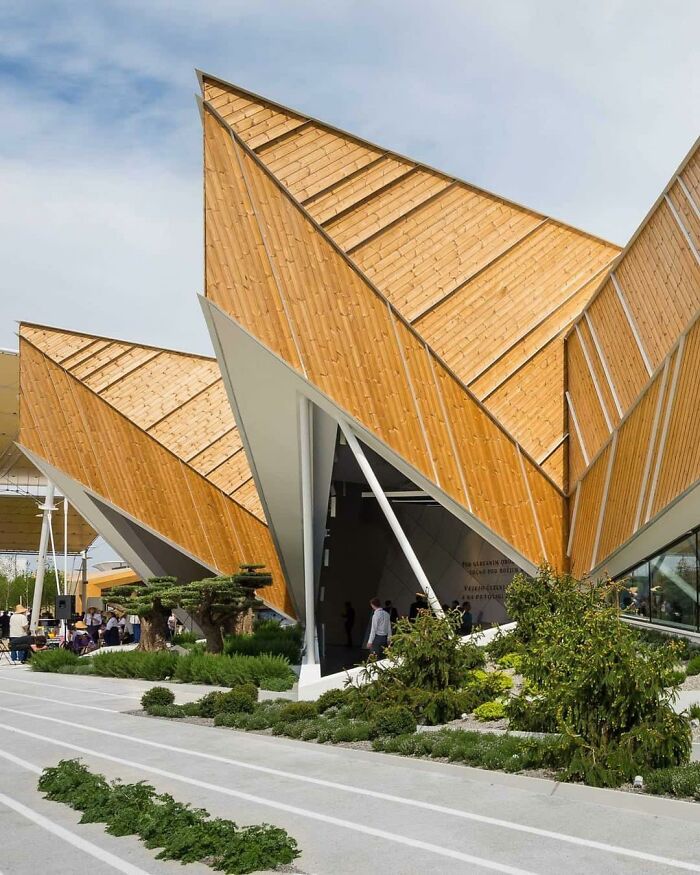Whether as an artform or a commodity, architecture is omnipresent. From homes to museums, commercial areas, or embellishments around the city—we’re constantly surrounded by architectural wonders. But some catch our eyes more than others, with a few exceptional ones even taking our breath away.
Architecture enthusiasts are often taken aback by the beauty of such marvels. Unsurprisingly, they’ve created an abundance of groups and pages dedicated to their appreciation, one of them being the ‘Parametric Architecture’ Facebook page. As the title suggests, it is devoted to a specific type of architecture, resulting in a unique collection of exceptional buildings and concept designs. Scroll down to find some of the most impressive examples shared by the page on the list below and make sure to upvote your favorites.
The Catalan architect Antoni Gaudi Cornet is considered to be the greatest architect of the twentieth century. He is known for creating architectural masterpieces which have an artistic/creative design innovation. The majority of his designs have been influenced by nature and mathematics.
Gaudi’s masterpiece project, the La Sagrada Familia is still under construction, with completion expected in 2026. He worked on the project until his death in 1926, in full anticipation he would not live to see it finished.
La Sagrada Familia utilizes three-dimensional forms comprised of ruled surfaces, including hyperboloids, parabolas, helicoids, and conoids. These complex shapes allow for a thinner, finer structure, and are intended to enhance the temple’s acoustics and quality of light. The interior of the church is like a stone forest, a kaleidoscope of colorful lights and shadow.
ParametricArchitecture Report
VTN Architects - Myanmar creates “Cave-Like” Nocenco cafe with swirling bamboo ceiling in Vinh city, Nghe An, Vietnam.
ParametricArchitecture Report
MASK architects has designed the world’s first eco-tourism-based safari resort in Africa which creates its own water autonomously by using "air to water technology" energy powered by transparent solar device covered curtain glass and envisions creating a sustainable-ecological community in Africa.
The aim of the project is not only to make a unique luxury residence but also to seek innovative, sustainable, and environmental solutions to problems based on constructive and restorative project generation processes arising from the geological, climatic, and environmental factors in which the project is located.
ParametricArchitecture Report
Designed by internationally renowned practice Snøhetta, Under is an impressive underwater restaurant located at the southernmost point of the Norwegian coastline. A unique confluence where the sea storms from the north and south meet, providing a natural abundance of biodiversity. This restaurant not only offers a stunning panoramic view of marine life but also functions as a research center for marine life. From the oak-clad foyer to the bespoke textile-clad interior, every detail is crafted with care.
Photos by Ivar Kvaal.
ParametricArchitecture Report
Designers Kristof Crolla & Julien Klisz visualized the YEZO as a retreat center for the idyllic Hokkaido in Japan. The project is designed with an experimental design approach to create a sanctuary in nature, and to use the dramatic landscape of the surroundings.
The YEZO’s overall design is a fusion of both aesthetics and algorithms, optimised for fabrication from one single mould to minimise ecological impact and reduce manufacturing cost and delivery time.
ParametricArchitecture Report
The Little Island: Blossoming Greenways designed by Heatherwick Studio opened to public in New York. Resembling tulips rising in varying height enthrals to capture magnificence and drama. Thomas Heatherwick’s Pier 55 park within New York’s Hudson River renamed as Little Island sparks waves among the citizens. Visuals reveal cast-in concrete planters lifted by cranes to sit atop poles in the water.
ParametricArchitecture Report
Architect @veliz_arquitecto has visualized a series of cabins on a mountain top to serve for the temporary visitors. These cabins with their unique wooden structure are uniquely attached with the surrounding environment of the mountains.
ParametricArchitecture Report
Step inside the sculptural sauna in the form of a golden egg-shaped chamber created by artists Bigert & Bergström in Kiruna, Sweden. Solar Egg is comprised of 69 separate pieces of gold-plated stainless-steel sheets, which come together to form the multifaceted oval. Located 145 kilometres north of the Arctic Circle in Swedish Lapland, the egg-shaped form is intended to make reference to the climate, with the snowy surroundings reflected in the golden mirrored surface.
Picture: Jean-baptists Béranger
ParametricArchitecture Report
Hyperbolic parabola structures of the L ́Oceanogràfic in Valencia, Spain designed by Felix Candela. Spanish born architect Felix Candela used thin-shell reinforced concrete to create his signature hyperbolic parabola structures. L’Oceanographic was his final project, which was completed posthumously (1997).
Félix Candela is one the greatest architects of the 20th century. Candela was known as being able to transform concrete into visual poetry with his structural design based on hyperbolic paraboloids, or thin-shell structures, as they were more often called.
ParametricArchitecture Report
REMM Studio designed a modern coffee house which inspired by traditional Iranian architectural forms such as arches. The Coffee House structure is circular in shape to provide a 360-degree view of the surrounding forestry environment.
The concept design process began with the simplification of the previously mentioned forms; the shape of the arches was changed into three dimensions, and a new module was obtained. This module is repeated in a circular pattern around the central axis.
ParametricArchitecture Report
Southern Branch of Taiwan Palace Museum, designed by KRIS YAO l ARTECH in Taibao City, Taiwan, is composed of three distinct sculptural fluid forms representing three Chinese calligraphy strokes: the thick ink, the half-dry, and the smearing. All three forms have different functions. The solid form contains the curatorial department and exhibition halls; the glass-and-steel “void” volume houses the museum lobby, café, library, and administration offices; the third smearing stroke flows through intersecting solid and void forms, connecting spaces with a smooth circulation pattern. The curved pedestrian bridge, which is an important part of the design, allows visitors to enter the museum from under the glass volume. The exterior of the solid form is covered with cast aluminum disks attached to the curved surfaces.
by Shawn Liu Studio, Kyleyu Photo Studio, Jeffrey Cheng
ParametricArchitecture Report
The Oculus in New York City, an architectural marvel by Santiago Calatrava LLC representing the city’s strength and a beacon for resilience.
Picture: Shannon Demicoli Battisson
ParametricArchitecture Report
Huanglong Waterfront Bamboo Pavilion by Atelier cnS + School of Architecture, South China University of Technology. Architects designed a waterfront bamboo Pavilion at the waterfront steps, hoping to provide a cool place for residents and tourists who enjoy the water culture of Huanglong Village.
The waterfront bamboo corridor adopts a double-side cantilever method, utilizing the toughness of original bamboos to realize the integrated design of structure and facade. Combined with the steps, it provides the maximum waterfront grey space. The Bamboo Pavilion is multi-functional, integrating recreational space, water theatre and wharf in one and activating the new look of Huanglong Village.
Picture: Ruibo Li, Li Chen
ParametricArchitecture Report
Park Music Theatre and Exhibition Hall; Located in Tbilisi, Georgia, and designed by Massimiliano & Doriana Fuksas, the building's reptile-like form makes reference to amplifiers that carry the music out of the chamber.
The building consists of two different soft shaped elements that are connected as a unique body at the retaining wall. Every elements has his own function: The Musical Theatre and the Exhibition Hall.
ParametricArchitecture Report
The Twist Museum is BIG - Bjarke Ingels Group‘s sculptural form in Jevnaker, Norway, revealing a beam that bends at 90 degrees while visitors wander the park-specific works of international artists such as Anish Kapoor, Olafur Eliasson, Jeppe Hein, and Fernando Botero cross the Twist to complete the art tour.
The simple twist in the building’s volume allows the bridge to rise from the lower, forested shore in the south to the hillside area in the north. Accessible from both sides, the building offers an uninterrupted path through the landscape. The structure, which functions as a bridge and an exhibition hall, consists of flat aluminum panels. White panels repeat themselves in the interior with white fir slats.
ParametricArchitecture Report
Chinese practice, MAD Architects reveals its winning design for the new terminal of Changchun Longjia International Airport in China. The terminal building is designed like a floating feather and, the long curve of the roof truly reflects the moving lines and spaces inside the airport.
ParametricArchitecture Report
3XN and SLA designed the Klimatorium as an innovative and creative mini-hub for storm surge, water, and climate research.
One of the main symbols of the building is a wooden ‘wave’ that rises above the main entrance and makes the building an easily recognisable landmark.
Located in Lemvig of Denmark, the motif is inspired by city’s characteristic fishing boats and is a tribute to the area's cultural history and local building customs.
Picture: Adam Mørk
ParametricArchitecture Report
The Future of Us Pavilion, located in Singapore between Marina Bay Sands and Singapore's Gardens, was designed for the Ministry of National Development on Singapore’s 50th Anniversary capstone event by Advanced Architecture Laboratory SUTD.
The design follows the traditional architectural structures that blend an intricate perforated skin form fluidly with the adjoining environment. The pavilion became a permanent landmark that serves as an essential public asset and venue for major public events. At the same time, it contains a range of cultural events, continuing its role as a public asset for the years to come.
Architect: SUTD Singapore University of Technology & Design
Location: Singapore
ParametricArchitecture Report
Henning Larsen' proposal for Vltava Philarmonic Hall is a distinctive, practical, and low-impact design, as well as a world-class musical experience for future generations, using a mix of steel, concrete, and mass wood materials. The structure is divided into three major volumes, each of which is built as a self-stabilizing concrete structure–a 'box in a box' idea –with concrete walls and concrete cores to reduce sound transmission from outside to inside and vice versa.
Architect: Henning Larsen
Location: Prague
Visualizations: Sora
ParametricArchitecture Report
Amazing shot from the concrete curvatures of the LabOvo, Labiomista, designed by Belgium based practice Van Belle & Medina Architects in Genk, Belgium / 2018.
Picture: Victor Dumont
ParametricArchitecture Report
UNStudio’s winning proposal for the Chungnam Art Museum in South Korea goes far beyond a traditional art museum. Designed in collaboration with DA Group, the museum is a fully immersive cultural and social experience for the entire community. Set to be a living, breathing space that will grow and change over time, the museum is designed as a place of inspiration, participation and contribution to both the art and local communities. The project also aims to become one of the first Zero-Energy museums in Korea.
ParametricArchitecture Report
The recent design proposal by fmzd for the Andisheh Housing.
Architect: Farshad Mehdizadeh
Photographs: Mohammad Jokar
ParametricArchitecture Report
Cineorama by Erika Hock is an outdoor viewing space, so you can sit and watch a couple of your favorite movies with your family and friends, within the comforts of your own backyard.
ParametricArchitecture Report
Chongqing LongFor - Hall of Waterfront City by Shanghai Tianhua Architecture Planning & Engineering. Ark of Light city exhibition hall, which covers an area of 950㎡ (floors area, with a site area of 20000㎡), is located at the commercial core of Lijia new area, the riverbank of Jialing River, and the new center of Chongqing, next to the only waterfront low-density business district of Chongqing and top residential area in the future.
The concept of the future is presented by the sense of antigravity, combing the tactility of fine gauze. To achieve that, architects used the method of parametric design when they dealt with that perforated aluminum panel, where holes in diverse scales actualized the initial concept of fine gauze. Under the gallery frame, they elaborately picked stainless steel plate with mirror coating as the gallery’s surface, and the result turns out to be like a galaxy with mini holes on plates and lightboxes in the dropped ceiling.
Yubei Qu, China
Picture: Shengliang Su, Yang Yuan
ParametricArchitecture Report
The E8 building by Coll-Barreu Arquitectos was designed as part of Alava Technology Park's expansion, and is a transformable architecture which can adapt to various uses.
Located in Vitoria, Spain the building implements a two-layered climate control strategy with an isolated internal shell and a ventilated exterior, providing significant energy savings and reduced emissions by distancing the interior from extreme outdoor temperatures.
ParametricArchitecture Report
Continue reading with Bored Panda Premium
Unlimited content
Ad-free browsing
Dark mode
Designed by Denton Corker Marshall in collaboration with artist Robert Owen, the Webb Bridge in Melbourne comprises two distinct sections: the existing structure (145m long) and the new curved, ramped connecting link (80m long) employed to take up level changes, creating a point of arrival at the south bank.
The new Webb Bridge allows users to appreciate the surrounding views and activities along the river and can be used as a destination in its own right, as well as a meeting point, or simply, a place of leisurely contemplation. As an object, it appears as a delineated structure, a sensuous volume, light and linear. Space is seen as atmospheric, dynamic and transitional.
Photo: Walking Perspective, John Gollings, Shannon MacGrath
ParametricArchitecture Report
Stunning interior shot from the Santiago Calatrava‘s Milwaukee Art Museum in Wisconsin, USA.
Photo by Hayden William Eakins.
ParametricArchitecture Report
Hotel Natura Extension is designed by ENOTA as a part of the touristic resort in Rogla, Slovenia.
The designers aim to "connect the unconnectable," integrating the eye-catching facade with the roof. The facade is visually transformed into a timber gable roof, historically characteristic of the environment. The timber on the facade is freely stacked and unprotected, allowing it to age and coalesce with the appearance of the surrounding landscape.
ParametricArchitecture Report
Fernando Romero has unveiled their proposal for Burning Man Project Temple. The concept is inspired by the Ancient Greek word holon, which refers to an object that is both complete unto itself and an integral part of a larger whole.
The temple's construction consists of a wooden truss system, devised by FR-EE to achieve its organic form. Each truss bows outward and is braced by 34 circular horizontal members, representing the 34 years of Burning Man's existence. A compression ring, the 35th horizontal member, caps off the truss system, framing a skylight and representative of the festival to come this 2020.
ParametricArchitecture Report
"Sculpting Vitality” is the Czech Pavilion proposed for the Expo 2025 Osaka by Apropos Architects. The pavilion aims to showcase the shaping of architectural spaces inspired by the movements of the human body and soul. Also, the dynamic ascending spiral is designed as a metaphor to demonstrate the ideal life path.
The frozen spiral path, revolving around the central hollow multifunctional auditorium tube, mirrors the internal layout that forms the outside of the building.
ParametricArchitecture Report
Observation tower, located on the River Mur (Southern Styria, Austria), is a sculptural structure that provides access to the ecology of the surrounding floodplain forest and enables the visitors to view the fluctuating river catchment and the surrounding landscape.
A double helix, appearing as a continuous trail climbing up through the trees, is the main concept of the tower. The viewing deck at a height of 27 meters offers a picturesque experience for visitors. The underlying concept behind the spiral-shaped walkways of the Mur Tower is the relationship between space and the experience of climbing up and down.
ParametricArchitecture Report
Haikou Xixiu Park Visitor Center, designed by MUDA-Architects, is an oval-shaped architecture with a highly transparent ultra-white glass facade in Hai Kou Shi, China. Open and unobstructed interior space provides a 360° panoramic view of the park. The glass curtain wall is joined with perforated aluminum sunshade louvers of different heights creating a rhythm. To provide a transitional experience to visitors, the open courtyard creates a contrast with solid spaces. The lines of the roof guide the light through the entrance and create illumination.
ParametricArchitecture Report
Astonishing scene captured by British photographer, Quintin Lake, from the Oriente Station (Gare do Oriente), in Lisbon designed by architect Santiago Calatrava in 1988.
📸 Quintin Lake
ParametricArchitecture Report
Architecture studio Tonkin Liu has completed a biomimetic tower containing flues for a low-carbon energy centre in Manchester, England, along with a sculptural wall made from organically-shaped tiles.
Tonkin Liu's architectural interventions form part of the city's Civic Quarter Heat Network and Energy Centre, which provides low-carbon energy to a network of key sites across the district.
ParametricArchitecture Report
Chemin des Carrières, the Quarries’ Track, designed by Reiulf Ramstad Arkitekter in Alsace, France, is a route to serve the quarries in harmony with the terrain and vestiges of the railway.
The pathway consists of undulating corten structures to provide different landscape and view experiences. 11km path splits into 5 sections each highlighting different landscapes where water is encountered frequently.
ParametricArchitecture Report
Japan National Stadium by Taisei Corporation + Azusa Sekkei Việt Nam + Kengo Kuma and Associates integrates Japanese-ness with multilayered “eaves.” Eaves are a component of traditional Japanese architecture, an established structure rooted in the Japanese climate. They contribute to creating environmentally friendly architecture by blocking sunlight and bringing a pleasant breeze to the stands. The large, flat roof is cantilevered, consisting of frames about 60m-long made of domestic wood and steel. This world-class stadium combines Japanese tradition, climate and technology.
In order to achieve superior quality and durability within the limited construction period, the cantilevered roof and stands are constructed of a simple steel frame, made of the same structure repeated in the circumferential direction. Precast materials were heavily used for the foundation and spectators’ seats. Employing a soft-first-story damping structure, the soft lower level with oil dampers effectively absorbs earthquake energy.
ParametricArchitecture Report
With a futuristic approach, Dubai Healthcare City is designed by Kalbod Design Studio to build a multi-functional complex focusing on medical services on Dubai seashores. The creative integration of digital and sustainable architecture, geographic and social conditions of the region, and acknowledging the future needs of tourists and citizens of Dubai were the primary fuels for designing the world’s largest medical tourism center in the Persian Gulf.
The crescent shape of the site plan symbolizes the architecture of Dubai’s region and the geometry of Burj al-Arab, as well as Muslim religious elements such as the lunar month. Also, the abstract combination of parametric forms and Islamic geometry patterns has been used in the grid designed for the site and higher levels.
ParametricArchitecture Report
Known for his famous 2 kilometers long concrete bridge, Sergio Musmeci is the intellectual engineer and a forerunner in the field of “form-finding.” Engineering, Aeronautics, music, and astronomy fed his curiosity and exceptional abilities to research scientific innovation. However, he addressed complicated problems through an empirical, almost artisanal method.
Sergio had devoted his entire life to studying vaults and minimum structures. Yet, the only project he has put into practice was the Musmeci Bridge which was the critical point in his career; he got the chance to reveal his vision. He designed a 30 centimeter thick double curved surface that emits a uniform compression.
ParametricArchitecture Report
“Pavilion of Clouds” built in the campus of BJFU in China for 2018 Bamboo Garden Festival, features a 120 square meters information hub that can later be turned into a recreational or gathering space.
Choice of bamboo provided SUP Architects the bending flexibility and easy processing either on site or in factories, which made it achievable for a pliable structure. Also, bamboo is known for weather-resistance capability once it had been given its shape and dried. Digital design tools led to the final design, the parts produced step by step after consulting bamboo contractors and structural engineers.
Central cone was the first piece to be made to hold the important parts of the pavilion, then the curved beams were formed followed by laying the bamboo crossing grid. Bamboo tile and PMMA were chosen as roof materials to prevent from rain and daylight which could also be adapted to the design easily.
ParametricArchitecture Report
Villa Marteau new Concert Hall by Peter Haimerl Architektur is characterised by 33 large expressive granite splinters, which are studded around a central stage on the walls and ceiling like a solidified explosion. For this purpose, thin granite slabs were mounted on a steel substructure - the largest elements are up to 13 metres long and weigh almost nine tonnes.
The splinter-like, tetrahedron-shaped granite elements define the spatial effect, with a corporeal and moving appearance, and have been placed to model the acoustics of the new hall.
The New Hall is characterised by a central concert stage flanked by two stands arranged in dialogue with one another. Space-defining bodies of granite extend in a sculpturally expressive manner above these two rising spatial elements.
They dynamise the space around the stage, with their powerful and expressive directionality whilst magically illuminating it through the backlighting of the splinters. At the same time, floating crystalline light bodies illuminate the stage space.
Picture: Edward Beierle
ParametricArchitecture Report
Ellipsicoon pavilion by UNStudio.
A cocoon-like synthesis of indoor and outdoor space. Its sides taper inwards as they rise, creating a hollow knot like structure with differently proportioned openings.
As a handwoven structure, the Ellipsicoon is constructed from strands of 100% recyclable high-density polyethylene (HDPE).
This material, woven with hand weaving techniques by highly skilled craftsmen around a frame, allowed the fluid contours and openings of the space to be created.
ParametricArchitecture Report
The new Tianfu Agriculture Exposition, designed by CADG in China, is Asia’s largest timber structure with an area of over 75,000 square meters. This vault series employs unique Vierendeel-inspired trusses, a hybrid of timber chords and steel webbing, to achieve clear spans of up to 110m and heights of up to 44m.
The open-ended roofs of the halls are clad with ETFE, creating a direct connection with the surrounding farmland and housing museums and displaying agricultural products from the region.
ParametricArchitecture Report
The Penleigh and Essendon Grammar School (PEGS) Music Centre, designed by 🖋 McBride Charles Ryan, where existing single-level Victorian 'house' is used by the School for music tuition, located in📍Melbourne, Australia.
The structure incorporates standard classroom components into an original formal composition, with a design objective centered on pursuing joy and beauty, allowing the design to transcend the technology and materials utilized. Beauty, like music, has its utility.
ParametricArchitecture Report
Hubei Science And Technology Museum Integrates The Traditional Chinese Philosophical Thought Of “Heavenly Round Place”.
ParametricArchitecture Report
"The Outdoor Room," Nuru Karim’s proposal for the Royal Botanic Gardens, Kew, and the Museum of Architecture competition to design treehouses across Kew UNESCO World Heritage Site. The proposal explores the inter-relationship between ”tree," "house," and "landscape" to create a unique design experience inspired by nature, driven by technology.
The proposed Tree House design is an inside-outside experience that can be accessed by all age groups and aims at creating a sense of "place" and “recreation." Horizontal platforms are defined for access, seating, reading, and meditation. These platforms aggregate, proliferate, and rotate differentially to morph from “landscape to skin.” The project is "light-footed," fabricated in GluLam & Cross Laminated Timber CLT, advocating sustainability, and respect for the climate and the earth's resources.
ParametricArchitecture Report
Melike Altınışık Architects - MAA unveiled the proposal for the Seoul Metropolitan Library in South Korea. The project was planned to create a core cultural facility with an urban cultural park that will serve as a base for the community in Seodaemun by integrating housing, educational, job, cultural, and commercial functions.
The library is expected to instill new vitality in the region as a cultural network for citizens to preserve cultural heritage through a sustainable architectural vision while also serving as a cultural living room and learning center. In a natural park setting, the community will gather to communicate and plan their future.
ParametricArchitecture Report
International architecture firm, Safdie Architects, proposes the Speculative Project for the city of Seoul in South Korea . The practice plans an entire three-dimensional city district organized around a public garden. While connecting people across multiple indoor and outdoor levels, the garden would act as the main orienting device for all the component parts.
ParametricArchitecture Report
Îlot Balmoral is a sustainable creative building designed by Provencher_Roy as a home to National Film Board (NFB) head office explicitly planned for its filmmaking activities. The building rotates around two architectural structures of 13 stories, separated by an atrium that provides excellent natural light.
ParametricArchitecture Report
Stanley Street Car Park in Manchester by @weareahr designed with a unique cladding system comprising of a single panel type tessellated across the façade and optimized to aluminium sheet dimensions to minimise waste and light pollution to nearby adjacent residential buildings.
The architect has created a visually interesting, distinctive and sculptural façade that makes a positive and memorable architectural statement on the gateway site into New Bailey and the adjacent Manchester city centre.
ParametricArchitecture Report
Waterline Park, designed by @labdh_seoul in Chengdu, China, connects four fragmented land parcels through a series of interrelated water. Different water zones of different heights adapt to the varying heights of the environment.
While using water as the main character, the design provides interactive stopping points connected with nature for people to rest and enjoy.
ParametricArchitecture Report
The new private gallery design proposed by Chybik + Kristof Architects & Urban Designers for the center of the new public square in Bratislava, Slovakia. The concept of the building is designed to be located on the pedestrian axis connecting the two natural areas of the city along the meandering riverbank with access to water. The building incorporates local history and urban development modernism in its design model. The region was known for its mining, smelting, and minting industries.
ParametricArchitecture Report
The trefoil-shaped 'Mobility Pavilion,' designed by Foster + Partners inspires expo 2020 Dubai to visualize the future. The space will present an exhibition of smart cities and the role of artificial intelligence, big data, robotics, machine learning, and autonomous transport.
Standing outwards from the building's base, three large petals was built to contain a gallery designed by London-based design consultancy MET Studio. Aiming toward sustainability, the building is cladding with heat-reflecting metals and photovoltaic panels on the roof, to take advantage of solar energy.
Architect: Foster + Partners
Location: Dubai, UAE
Photographs: Moayed Bakhsh
ParametricArchitecture Report
ARC River Culture Pavilion by
Asymptote features a silver pillow-clad pavilion that was installed on an artificial river peninsula in South Korea as part of the World Expo 2012.
Asymptote designed an bowl-shaped structure clad in ETFE plastic pillows, which give a quilted texture and silvery colour to the exterior walls.
The building sits at the peak of a man-made hill. Visitors enter through a underground tunnel that leads through to exhibition galleries both above and below ground.
ParametricArchitecture Report
The iconic 339-meter Hengqin International Financial Centre tower, designed by Aedas with a spirally rising volume, invokes the Chinese myth of flood dragons emerging from the sea – a perfect metaphor for the strength and power of the region.
Inspired by "The Nine Dragons", a famous stroll of Chinese painting from the Song Dynasty, the design embodies the convergence of energy in the architectural form. The traditional totem of the dragon emerging from the sea symbolizes new life breaking through the barriers and ceaselessly flourishing into an imposing power.
ParametricArchitecture Report
Leixões Cruise Terminal by Luís Pedro Silva Arquitecto in Matosinhos, Portugal / 2015. Enchanted by the jetty's curve and by this intermediary commitment and role, it enlaces the curved blades generating and prolonging itself in the form of 3 main exterior tentacles and a fourth falling inwards, in an helical ramp connecting the internal functions within a quadruple height space. The unrolled exterior arms lead the investigators level to the seaside and the departure level to the cruise gangway or to the elevated walkway towards the beach and Matosinhos city.
ParametricArchitecture Report
Haus Balma, designed by Kengo Kuma and Associates in Vals, Switzerland, is a residential and commercial building formed like a pagoda. The structure’s unique form harmoniously blends with nature. The building is surrounded by floating Valser quartzite stone panels and wood plates, creating a balance between lightness and heaviness.
Photo by Paul Clemence.
ParametricArchitecture Report
The King Abdulaziz Center for World Culture is a bold new initiative located in Dhahran, Saudi Arabia, fostering the Kingdom's cultural development. Designed by 🖋 Snøhetta, the project offers a diverse range of programs to the local community and has established itself as a cultural landmark on a regional, national, and worldwide scale.
The composition is divided into five 'pebbles,' smooth, shining objects that glisten in the light and appear mysterious and monumental on the horizon, with a 98m tower at the center, a smaller 'keystone' to one side, and three lower, sleeker buildings coming up out of the desert. This series of spherical structures are coated with metal piping lengths that make up the complex, and tubing follows the building's contours, encircling windows and doorways; some of the facades are left exposed to reveal the metal structure beneath.
ParametricArchitecture Report
Hanoi-based studio T-Architects folded the LZ’s Love Spa facade with transparent yellow aluminum panels in Thanh Hóa, Vietnam.
ParametricArchitecture Report
Slovenian Pavilion at Milan EXPO 2015 by SoNo Architects. One of the 142 participants at the world fair Expo Milano 2015 was also Slovenia. These exhibitions vary in character and were held every 5 years in varying parts of the world. The main theme was »Feeding the Planet, Energy for Life«. The importance of the World Exhibition in Milan was even greater for Slovenia, because of its immediate vicinity. Italy was also the first in number of tourists in Slovenia, the second most important foreign trade partner of Slovenia and the third largest foreign investor in Slovenia.
ParametricArchitecture Report
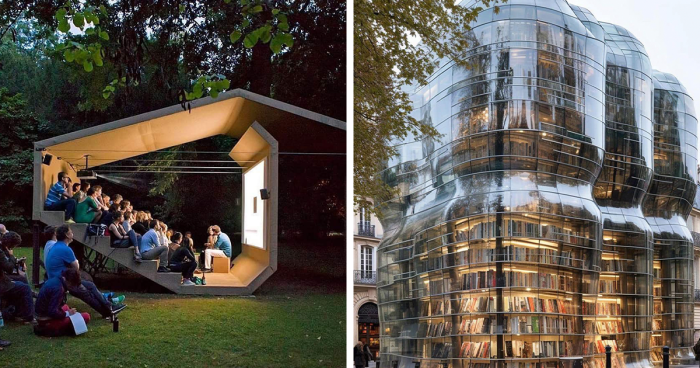
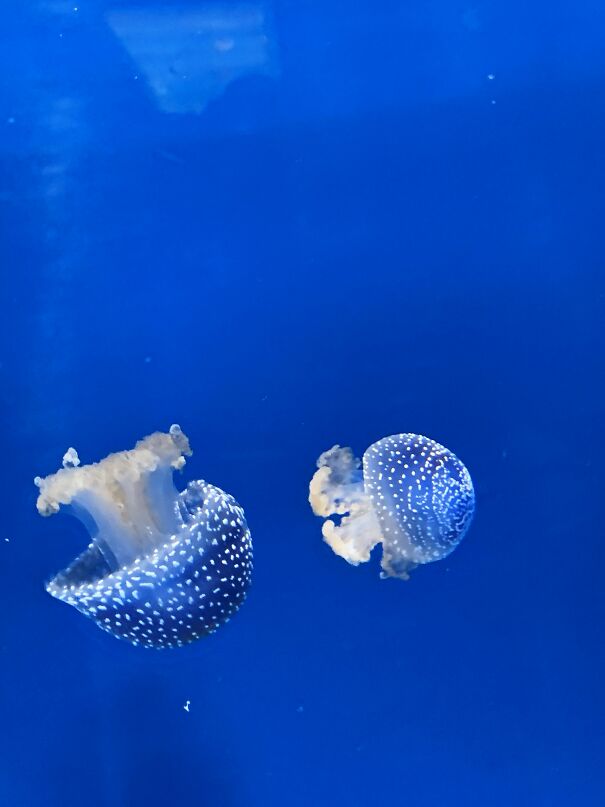

 Dark Mode
Dark Mode  No fees, cancel anytime
No fees, cancel anytime 




